New Hampshire State Police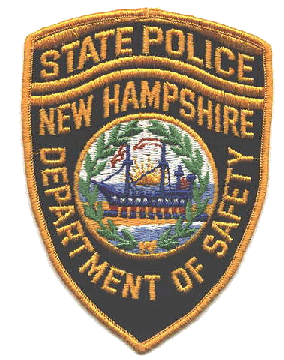
New Hampshire State Police
On July 9, 1869, a typical summer day in New Hampshire, Governor Stearns was presented with a hand written piece of legislation that would eventually lead to the formation of the New Hampshire State Police.
The legislation, entitled "An Act to Create a State Police in Certain Cases," outlined just what would constitute the proposed State Police. During this historical period, the various local law enforcement authorities chose not to promote compliance with the liquor laws. Therefore, one of the primary functions of the proposed legislation was the enforcement of these "anti-drinking" laws by the State Police.
The proposed legislation failed to achieve the needed backing of two-thirds of the male voters in New Hampshire. Fortunately, this setback did not diminish the interest and support of a large portion of the population of New Hampshire to have a State Police. The interest in such an organization was responsible for the formation of a State Police Commission. The "Report of State Police Commission to the Legislature" was presented to the January 1931 session of the legislature.
It formulated a comprehensive justification for the necessity of establishing a "State Police" and noted that "… today, with the development of a network of improved highways and the universal use of the automobile, a problem of law enforcement and criminal apprehension has been created for which the established system of local protection had proved inadequate." The Commission also suggested that the need for criminal investigators become a reality and recommended the creation of a State Detective Bureau. Up to that point in time, most State (and Country) criminal investigations were performed by private detective agencies. A final recommendation by the State Police Commission was concerned directly with the establishment of a Bureau of Records and Identification within the Department of State Police. In reference to this, criminal statistics, fingerprint taking and other methods of identification would be undertaken. The Bureau would also maintain records of revolver purchases and revolver permits issued within the State.
Bill No. 254, entitled "An Act Creating A Department of State Police" did not easily pass through the legislative process and found itself subjected to many amendments, readings and voting sessions. Ultimately, on June 29, 1937, the New Hampshire State Police was created and subsequently became a statutory reality as Chapter 134 of the Laws of New Hampshire. According to this statute, the law became effective July 1, 1937. The New Hampshire State Police became the 15th organization of its type in the United States.
During the first year of 1937, the New Hampshire State Police established its headquarters in the State House. At that time, the initial ranks were comprised of individuals who had been members of the uniformed branch of the New Hampshire Motor Vehicle Department and criminal investigators then employed through the State Attorney General’s office. The first Superintendent of the Department of State Police was George Colbath, the Sheriff of Coos County.
During 1937 the complement of troopers reached an authorized forty-eight men. These men would serve as the benchmark to what has become a tradition of law enforcement service reaching national acclamation. These volunteers were not ordinary individuals in any realistic view. Rather, they were truly a special breed, willing to endure long, arduous tours of duty, meager compensation and incredible personal risks. As the first New Hampshire State Troopers, they established an esprit de corps, a philosophy, and a total way of life that has transcended time and the evolution of social values. Their commitment to excellence without compromise has become the foundation for the proceeding years.
Harley Davidson motorcycles and a few Chevrolet sedans were the primary modes of transportation utilized by the early troopers. There were five Troops for uniformed operations, and General Headquarters included administration, criminal identification, traffic, and teletype bureaus.
In 1962, the New Hampshire State Police became a division of the newly developed New Hampshire Department of Safety.
Since its inception, the New Hampshire Division of State Police has experienced constant growth and expansion in all areas of endeavor. This growth includes an increase of sworn personnel to approximately 400 and the creation of a number of highly sophisticated and specialized units.
Prior to the official New Hampshire State Police formation in 1937, state traffic law enforcement in the Granite State was conducted by the examiners and inspectors of the New Hampshire Commissioner of Motor Vehicles (under NH Highway Department) from 1917 to 1937. These inspectors were commonly known as Highway Patrolmen. Therefore the earliest New Hampshire state trooper license plates only bore the designation "NHHD PATROLMAN" with no assignment number.
There is an embossed steel version of this plate that was issued as well as a flat-painted version. It is unknown which version was launched first.
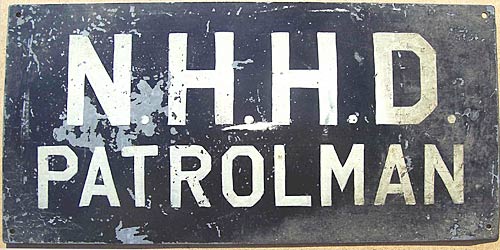 Pre-1937 issue. Flat painted steel. Approx. 6 1/2" x 14".
Pre-1937 issue. Flat painted steel. Approx. 6 1/2" x 14".
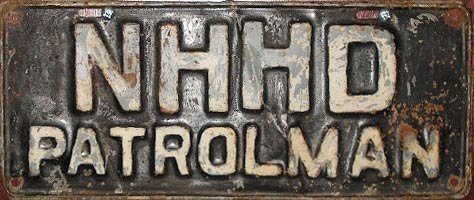 Pre-1937 issue. Embossed steel.
Pre-1937 issue. Embossed steel. 
Upon the formation of the State Police in 1937, distinctive red over white license plates were launched for NHSP cars. The plates were embossed steel and measured approximately 13 1/2" x 6". The plates had corner mounting holes as well as two elongated oval mounting slots on the top and bottom of the plate. NH was embossed at the top center with STATE over POLICE embossed over the left and center field of the plate. An assignment number up to two digits occupied the right field of the plate. The plate had an embossed perimter border. These license plates were used by the NHSP right through to 1950.
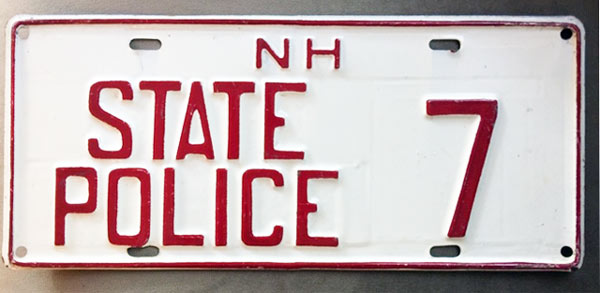 1937-Circa 1950 issue.
1937-Circa 1950 issue.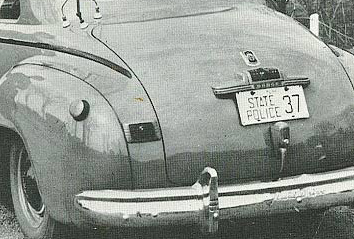
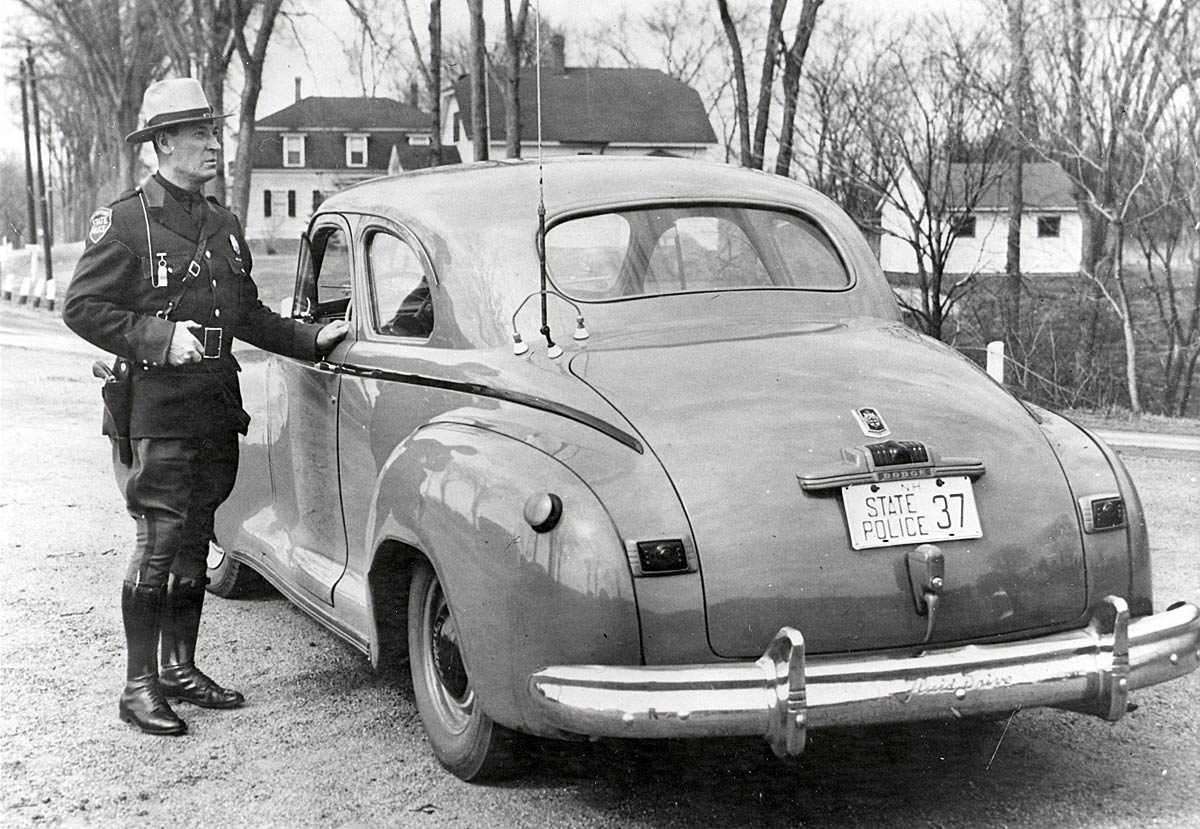 Circa 1940
Circa 1940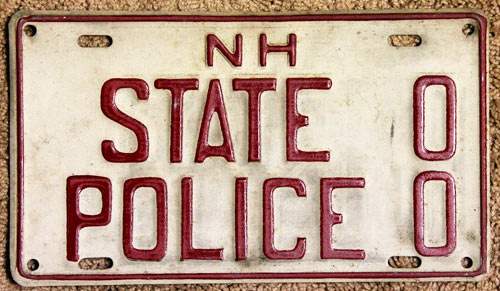 Circa 1954 prototype. Embossed steel.
Circa 1954 prototype. Embossed steel.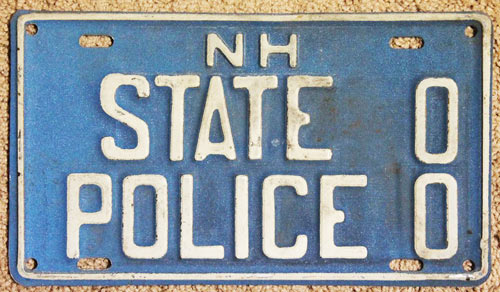 Circa 1954 prototype. Embossed steel.
Circa 1954 prototype. Embossed steel.Around 1950, the NHSP introduced a flat silkscreened license plate made initially on steel and later on sign grade aluminum. The color and format followed the previous issue. The plates were initally also the same dimensions as the previous issue, however the font size used for STATE POLICE was now smaller and allowed for a three digit assignment number as seen on the period photo of NHSP license plate #50 seen below.
The N H was also centered more to the left side of the plate.
The older embossed steel license plates were also still used concurrent to this issue.
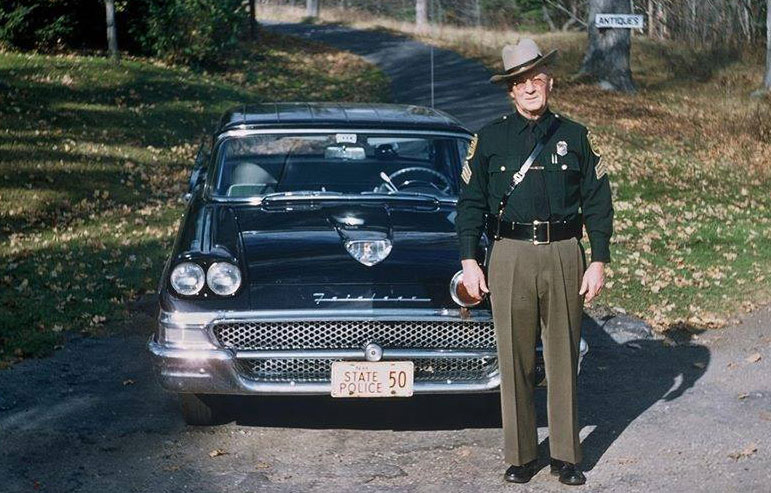 1958- Still using the long pre-1956 (13 1/2" x 6" ) version.
1958- Still using the long pre-1956 (13 1/2" x 6" ) version. In 1956, a new uniform standard measurement of 6" x 12" for car/truck/bus license plates was mandated for North America. License plates of the NHSP followed suit, and in some cases: in drastic fashion. Some of the pre-1956 license plates measuring 6" x 13 1/2" that had already been made prior to the new standard were literally chopped-down to comply with the new requirement, however assignment numbers situated on the right end of the plates were cut off. This can be seen on NHSP plate number 38 seen below.
Newer issues such as plate number 86 shown further down, were made in the new and proper 6" x 12" fashion, however they were made over the older issues that had already been made the year before. 1956 NHSP license plate number 86 is actually made over 1950-1955 NHSP license plate number 25 as the older lettering can be seen under the newer sheeting. These newer issues also all used periods after the N and the H. If one looks at the right edge profile of this plate, markings are visible of where the other half inch of the plate had been cut off prior to the new sheeting being applied.
These plates were used until 1962.
The older embossed steel license plates were also still used concurrent to this issue.
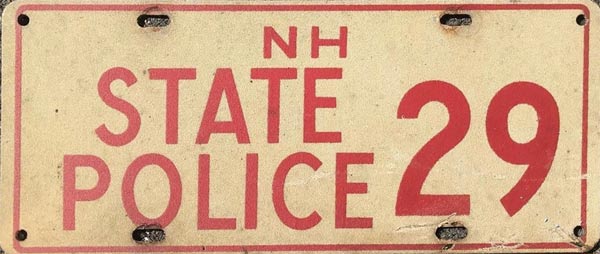 Circa 1956 issue. Silkscreened metal.
Circa 1956 issue. Silkscreened metal.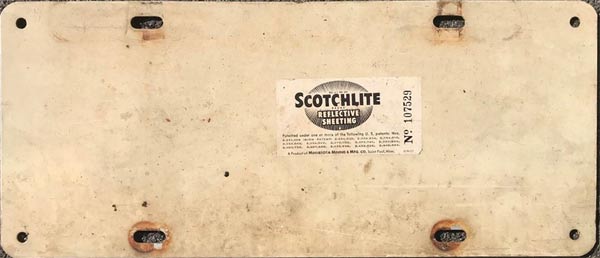 Reverse side of # 29 showing 3M Scotchlite patent decal with serial number.
Reverse side of # 29 showing 3M Scotchlite patent decal with serial number.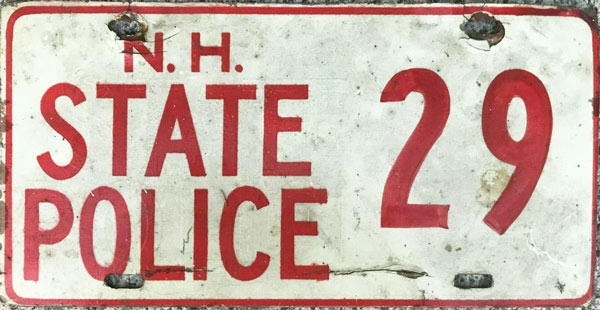 Circa 1956-1962 issue.
Circa 1956-1962 issue. 
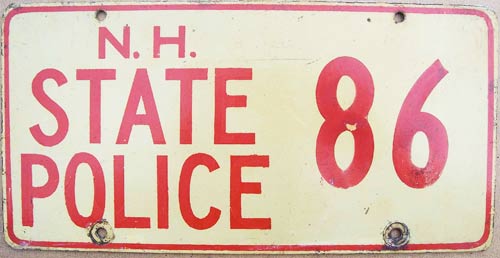 1956-1962 issue. Flat screened aluminum.
1956-1962 issue. Flat screened aluminum.
Beginning in 1962, many of the flat-screened NHSP license plates from the years prior, were recycled and used as Tramway Registration plates for use on New Hampshire ski industry conveyances such as the Tramways used on Cannon Mountain in Franconia. The registration of such conveyances was established by the state's Department of Safety to oversee the safe and enjoyable use of the the state's ski industry resources. These Tramway registration plates indicate the annual safety inspection conducted to ensure compliance with the law and safe operating procedures.
The reverse side of some of these "Tram plates" have revealed many former New Hampshire State Police license plates (all the flat-screened type) that were trimmed down to the smaller size used for the Tram plates. Often the reverse side of the Tram plate is painted black with the NHSP lettering/numbering hidden beneath the black paint. Some were never painted at all and show the "previous life" of the State Police functions it was once attributed towards.
Seen below is an example of an "uncovered" flip-side of a late 1950's New Hampshire State Police license plate #82 that was trimmed down and once painted black to be the underside of New Hampshire Department of Safety Tramway Registration #257, validated up to 1978.
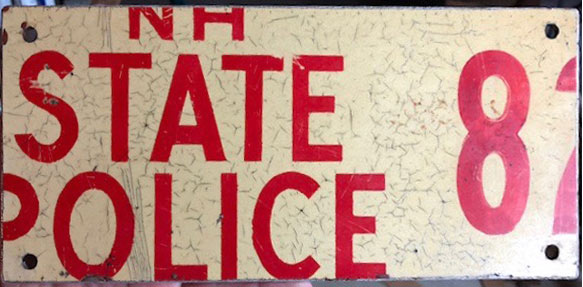 Backside of 1978 "Tram plate" # 257 seen at right. This was covered in black paint when this old NH State Police license plate #86 was re-purposed for a new life as a Tramway Registration plate. The new owner was able to see the old lettering/numbering and used a special solution to dilute and remove the black paint for this great reveal.
Backside of 1978 "Tram plate" # 257 seen at right. This was covered in black paint when this old NH State Police license plate #86 was re-purposed for a new life as a Tramway Registration plate. The new owner was able to see the old lettering/numbering and used a special solution to dilute and remove the black paint for this great reveal.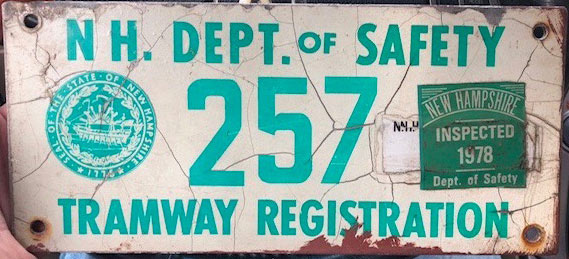 The NH Department of Safety Tramway Registration plate that hid the old NH State Police license plate #82 on its backside.
The NH Department of Safety Tramway Registration plate that hid the old NH State Police license plate #82 on its backside.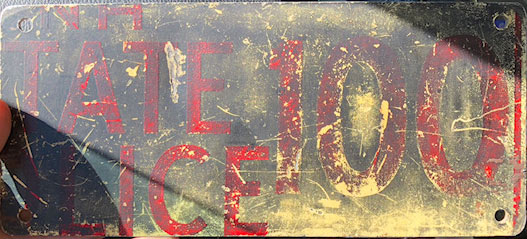 Another late 1950's era NH State Police license Plate #100 trimmed-down and covered in black paint as a flip-side to another NH Tram plate. Seen in original form at right.
Another late 1950's era NH State Police license Plate #100 trimmed-down and covered in black paint as a flip-side to another NH Tram plate. Seen in original form at right.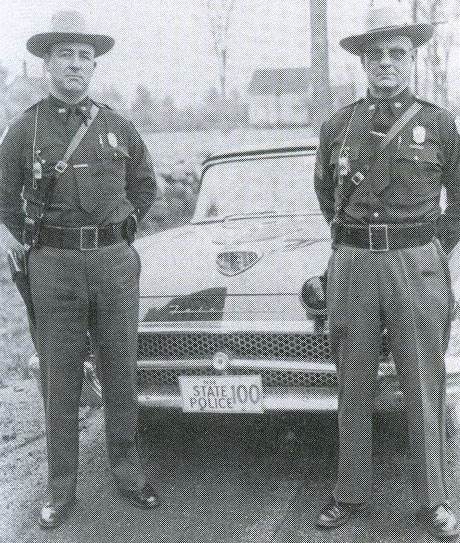 The same #100 NH State Police license plate seen at left when "on duty" in 1958 !
The same #100 NH State Police license plate seen at left when "on duty" in 1958 !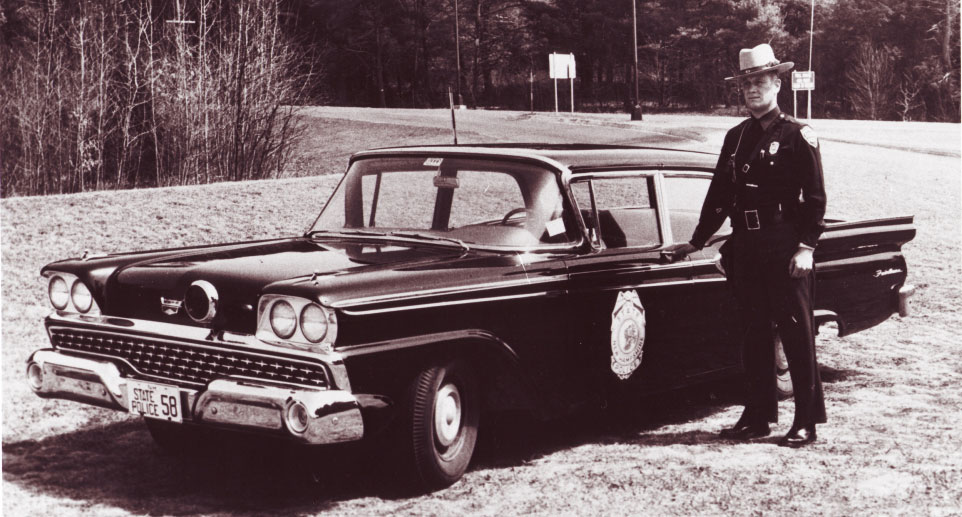 1959- Still using the older embossed steel issue.
1959- Still using the older embossed steel issue.As stated earlier, in 1962, the New Hampshire State Police became a division of the newly-formed Department of Safety. As a result, the NHSP began running newly-designed license plates on their marked patrol vehicles.
The earliest versions were made of embossed aluminum with no background color (raw aluminum) and consisted of four mounting holes on the top of the plate and four on the bottom which included corner holes. The full state name NEW HAMPSHIRE occupied the top length of the plate and DEPT. OF SAFETY occupied the bottom length. These characters as well as the perimeter border were painted in dark green.
STATE over POLICE was embossed in the left center field of the plate and painted in red, and the assignment number up to three digits was embossed in small 2" high dies also painted in red.
A NHSP license plate with identical format but with a larger 2 7/8" high mitered die bearing number 2 and with all red embossed characters over a reflective white background as seen below exists. It is unknown if this plate is a one-off prototype or if it was a short-lived issue. Given that no other evidence of any other plate of this type has been uncovered, it is likely that it was indeed a prototype from that era.
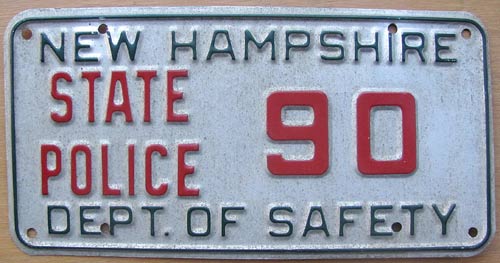 1962-Circa 1964 issue.
1962-Circa 1964 issue. 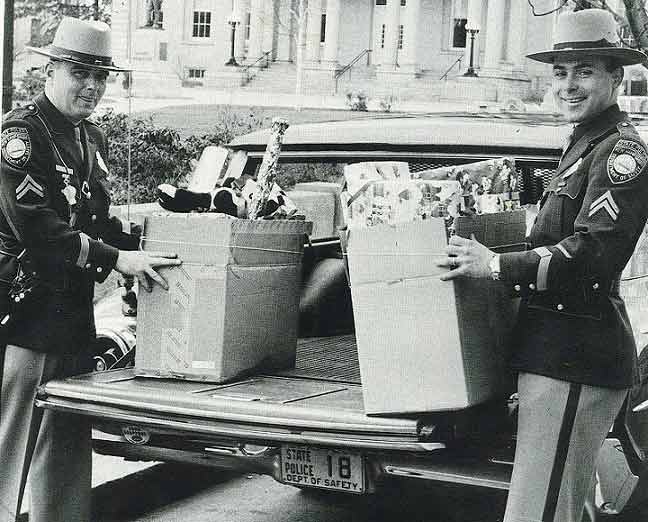
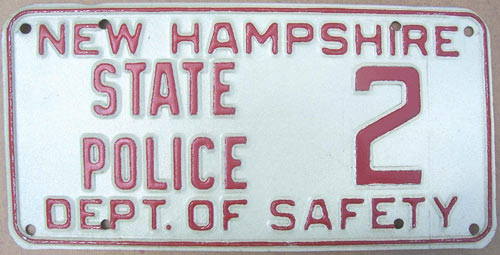 1962-Circa 1964 "all red" issue.
1962-Circa 1964 "all red" issue.
 Troop F troop inspection 1962
Troop F troop inspection 1962 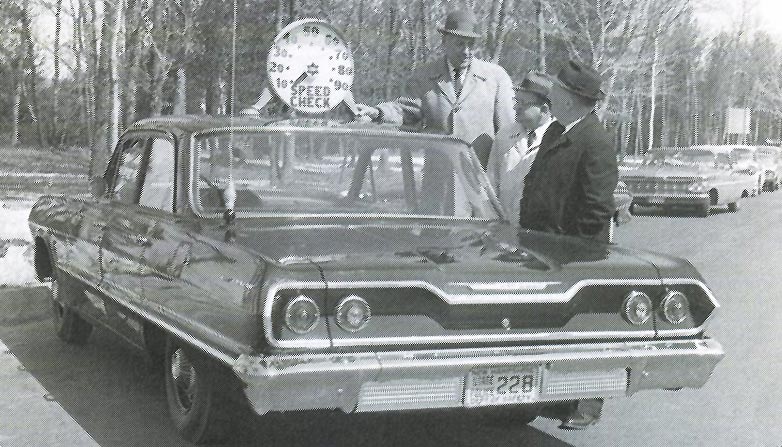 1962-1964 issue NHSP license plate number 228 seen above but with what appears to be the larger 2 7/8" high mitered dies for the numerals. Possibly a patrol car assigned to the Turnpike.
1962-1964 issue NHSP license plate number 228 seen above but with what appears to be the larger 2 7/8" high mitered dies for the numerals. Possibly a patrol car assigned to the Turnpike.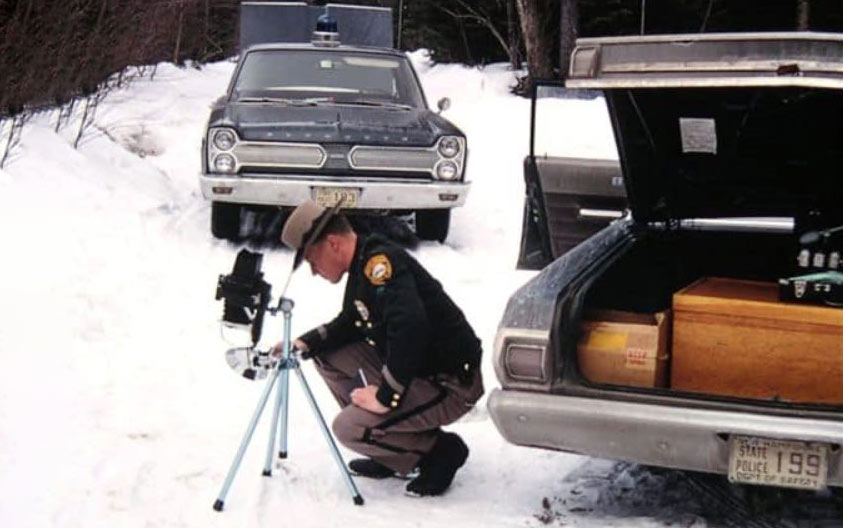 Troop A- 1966
Troop A- 1966It was during this time that it is believed that the NHSP began to gradually re-plate the fleet by adding a reflective white background and moving the state name to the bottom of the plate and DEPT.OF SAFETY to the top of the plate.
It appears that the plates had all the embossed portions painted in dark green on the production run, but then re-ran the plates through the painting process by adding red paint over the STATE POLICE and assignment number of the plate. This layout continued with minor material and die variations until 1997 which is why most of these plates have the dark green paint visible beneath the red.
It is also widely believed that it was also during this time when the assignment number of the license plate reflected the Troop and radio call number of the trooper.
The earliest indicators are that license plate/radio numbers were assigned in chronological order from senior headquarters assignments into troops based on the cut-off numbers for each troop. As the years progressed, the number blocs increased for each Troop.
Headquarters officers, investigators, communications and other specialized services ran single and double digit numbers.
Contrary to the full hundred-number blocs used to represent each Troop as known today, the earliest number assignments were split at the 50 mark in each bloc of 100.
For example by 1971:
Troop A (Epping) was assigned the 100 bloc.
Troop B (Milford) was assigned the 150 bloc.
Troop C (Keene) was assigned the 200 bloc.
Troop D (Concord) was assigned the 250 bloc.
Troop E (West Ossipee) was assigned the 300 bloc.
Troop F (Twin Mountain) was assigned the 350 bloc.
Turnpike Troop numbers were assigned in the 400 bloc
Trainees numbers were assigned in the 450 bloc.
The Commander for each troop, usually a Lieutenant was assigned the "double zero" plate for the given Troop such as 100, 150, 200, 250 etc...
The Assistant Troop Commander would have the 01 designation, such as 101, 151, 201, 251 etc...
The 02 to 06 numbers would typically be issued Sergeants or Corporals ( Corporal rank later abandoned) and numbers up to 49 would be road troopers based on assignment number.
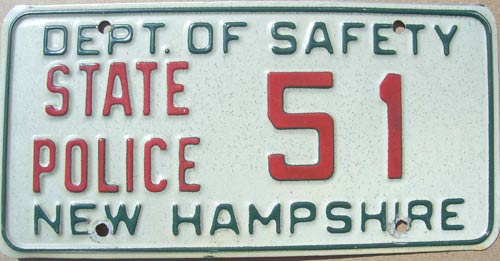 Circa 1963-1977 issue.
Circa 1963-1977 issue.
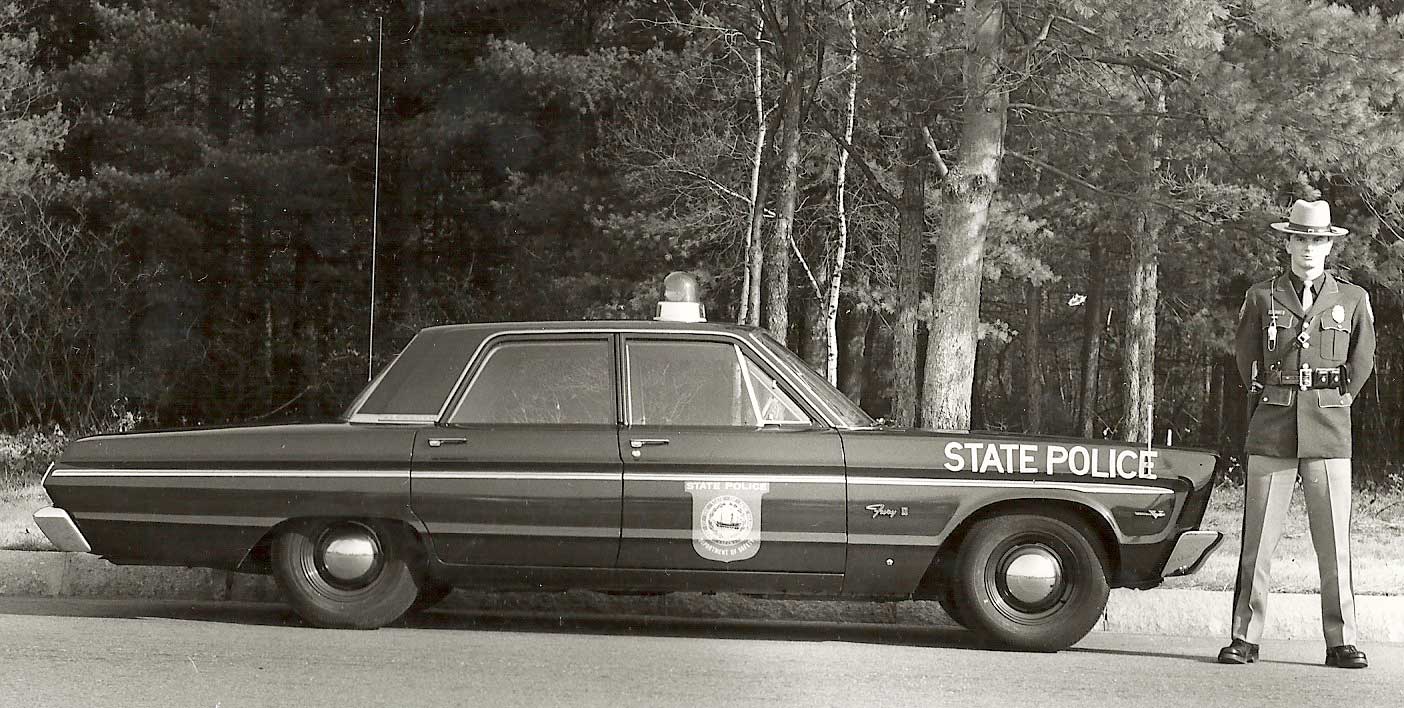
As time moved-along into the early 1970's, the base plate introduced in 1963 moved towards a more consistent use of the larger 2 7/8" high mitered dies and moved the monicker STATE POLICE to the extreme far left of the plate. The plates continued in use well-into 1977 as the fleet began to get re-plated with a new style introduced that year.
Troop plates were issued in the following number blocs:
100 series for Troop A (Epping)
200 series for Troop B (Milford-later Bedford)
300 series for Troop C (Keene)
400 series for Troop D (Concord)
500 series for Troop E (West Ossipee- Tamworth)
600 series for Troop F (Twin Mountain)
700 series for Troop G (Central Turnpike System) All Interstate highways except seacoast at that time.
800 series numbers were reserved for Probationary Troopers out of the academy.
In the early 1970's, the Commissioner of Public Safety merged New Hampshire Motor Vehicle Inspectors into the Division of State Police where they became known as Troop I. The short-lived Troop I had radio/license plate numbers reserved in the 750 to 769 bloc until they were dissolved into "Field Enforcement" by the Fall of 1980.
Troop designations are further described on map shown further below.
Assignment numbers from 1 to 99 were attributed to NHSP Headquarters. Typically broken-down this way but with some shifts in number blocks over time:
Numbers 1- 16 were allocated to senior HQ Staff.
#1 issued to the Colonel of the State Police.
#2 issued to Lieutenant Colonel and later, the Executive Officer of the State Police.
#3 through 6 issued to Majors.
#7 through 10 issued to Captains.
#11 through 14 no specific issuance.
#15 issued to Attorney General of the state.
#16 to the Adjutant General of the state.
#17, 18 and 19 are reserved for the Executive Security personnel.
#20 through 29 are reserved for HQ Administration.
#30 through 49 are reserved for Narcotics Investigators.
#50 through 59 are reserved for Special Investigations Unit.
#60 through 79 are reserved for the Major Crime Unit.
#80 through 89 are reserved for the Special Enforcement Unit (previously Aviation vehicles).
90 through 99 are reserved for Special Equipment such as EOD and Crime vans, aviation as well as the Command Post. # 999 was assigned to the Peacekeeper vehicle.
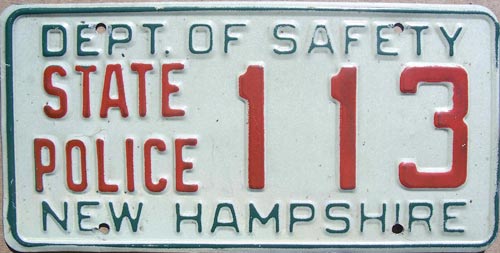 1963-1977 issue.
1963-1977 issue.
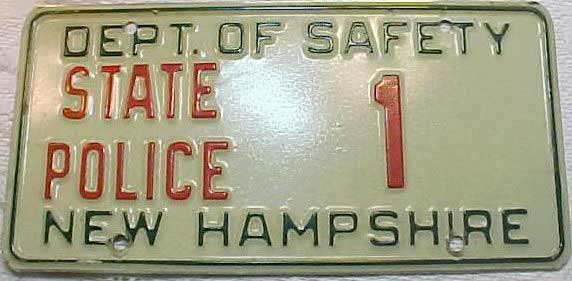 1963-1977 issue.
1963-1977 issue.
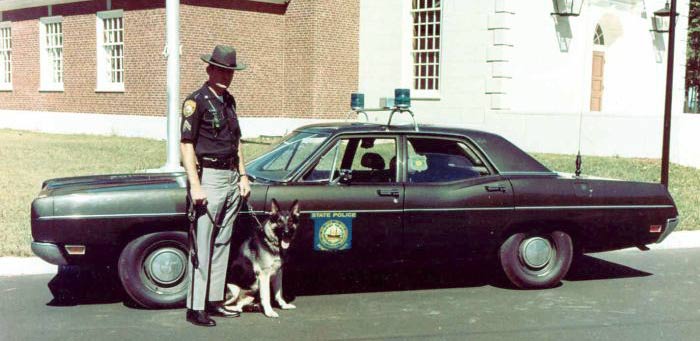
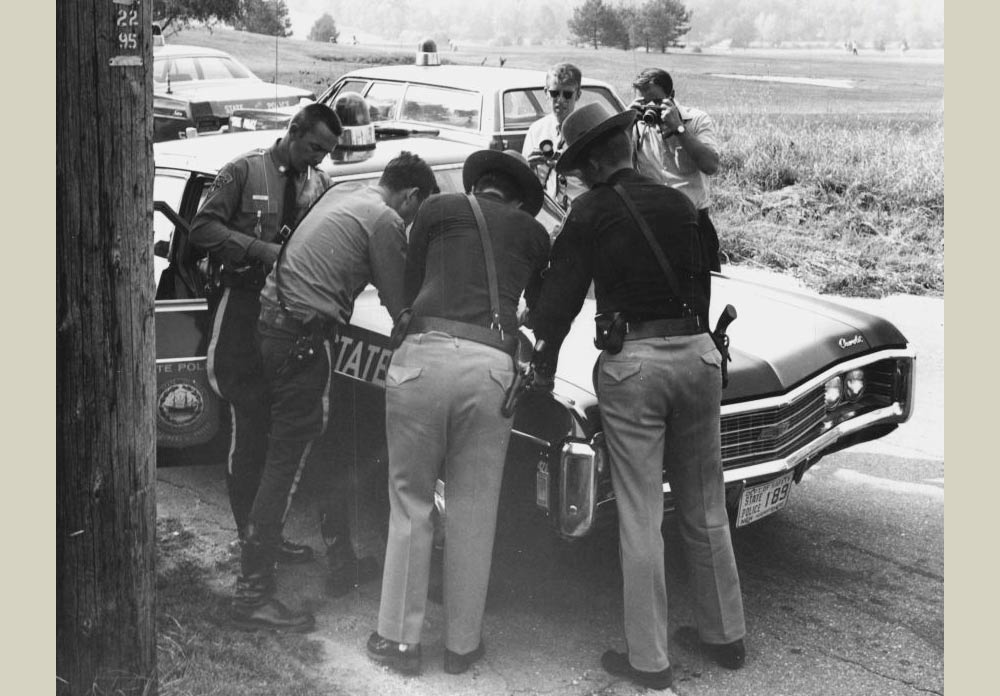
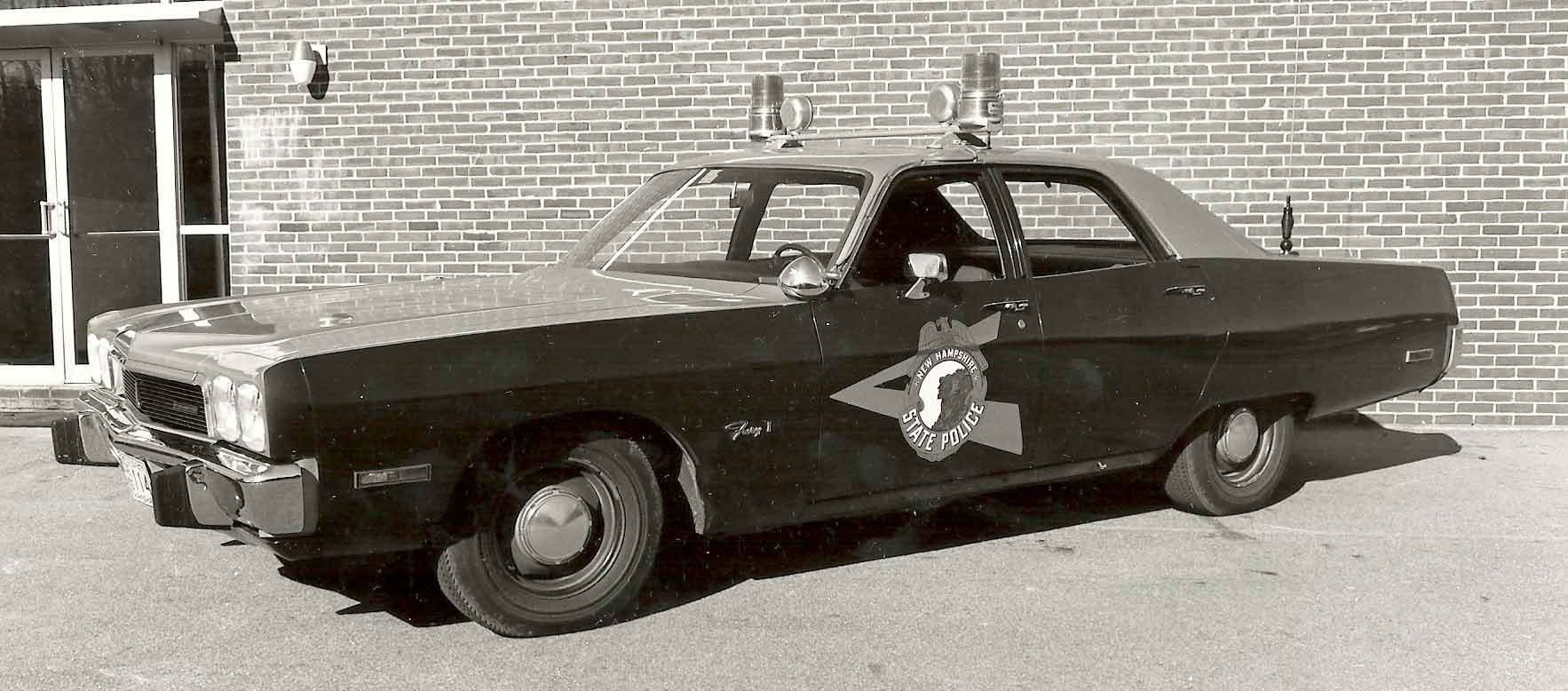
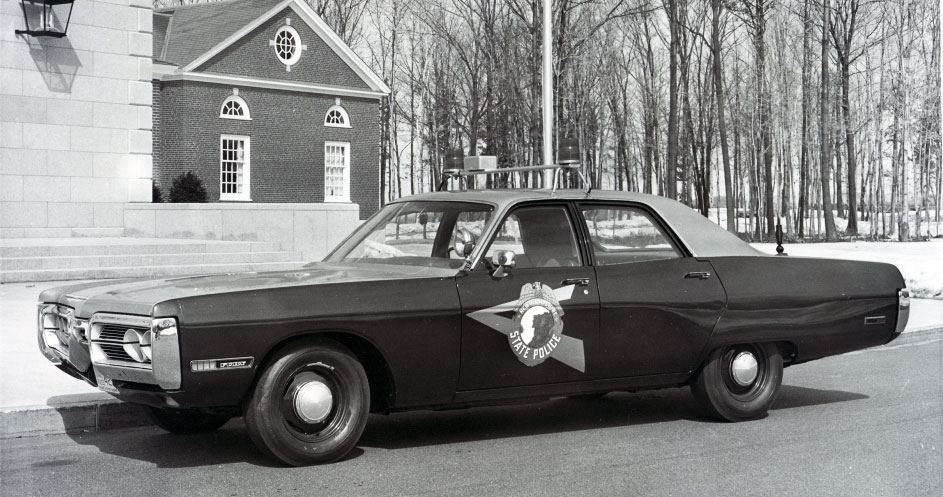
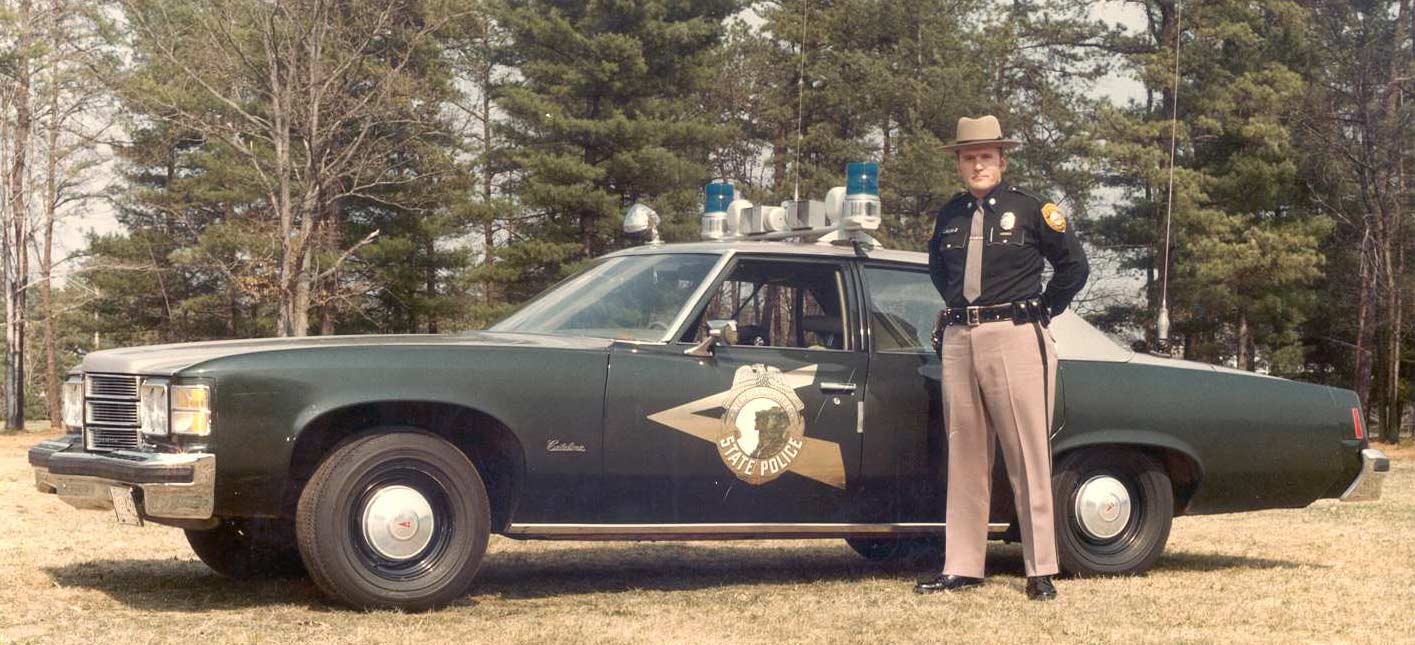 Trooper Skip Foisy with his 1974 Pontiac Catalina.
Trooper Skip Foisy with his 1974 Pontiac Catalina. 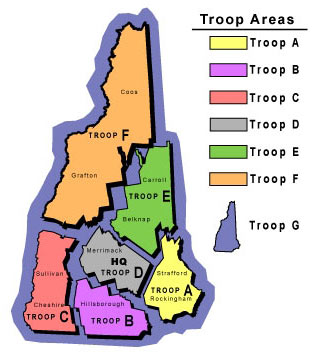
Troop designations are as follows:
Troop A (Epping)- NHSP license plates in 100 series.
Troop B (Milford-later Bedford)- NHSP license plates in 200 series.
Troop C (Keene)- NHSP license plates in 300 series.
Troop D (Concord)- NHSP license plates in 400 series.
Troop E (West Ossipee-Tamworth)- NHSP license plates in 500 series.
Troop F (Twin Mountain)- NHSP license plates in 600 series.
Troop G (Commercial Vehicle Enforcement/Field Operations/DMV Task Force/Special Services)- NHSP license plates in 700 series.
Plates with numbers in the 800's were dedicated to mostly probationary troopers and 900 series numbers were issued to NHSP vehicles not tied to a particular troop or assignment.
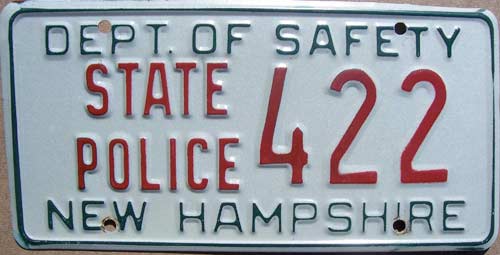 1977-circa 1980 issue.
1977-circa 1980 issue. 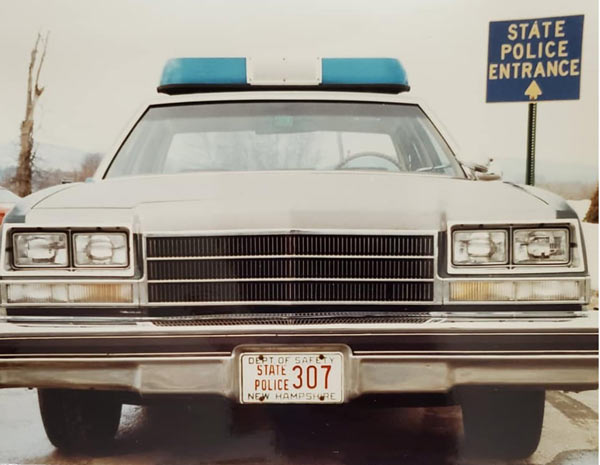

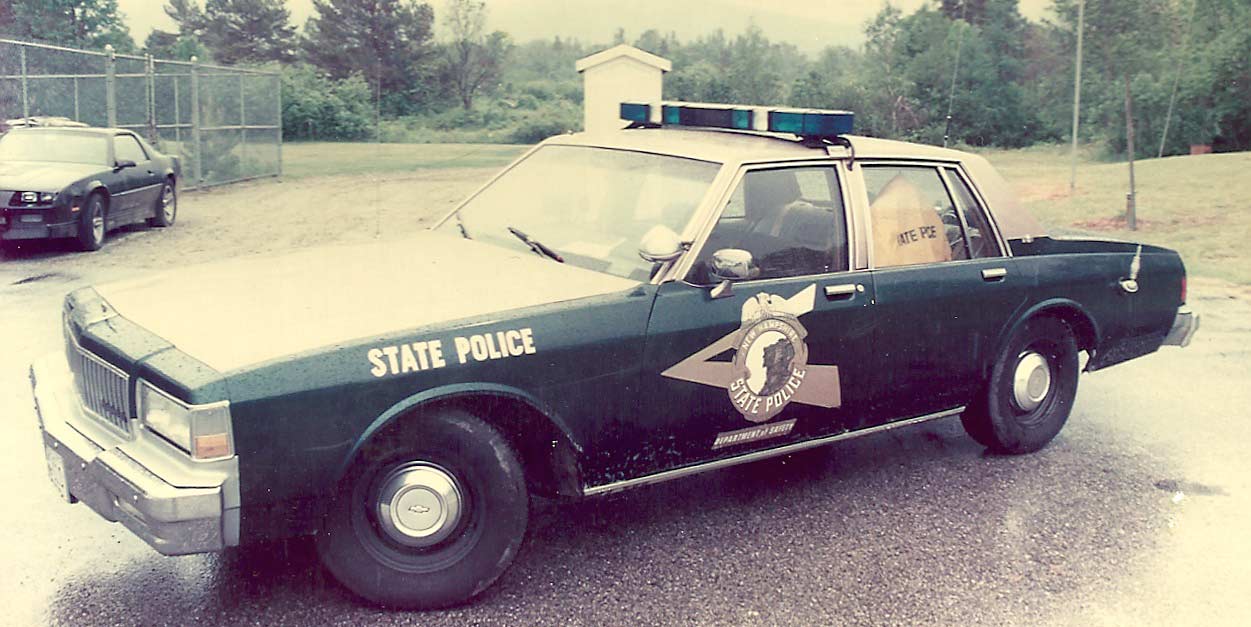
In 1980, a new version of the older format license plate for NHSP was introduced. The background was still reflective white and the raised characters were painted in medium green with a coat of red paint over STATE POLICE and the numerals again. This version of the NHSP license plate was distinctive by the smaller dies used for the state name on the lower portion of the plate. The smaller dies allowed the state name to be situated centered between the lower bolt holes.
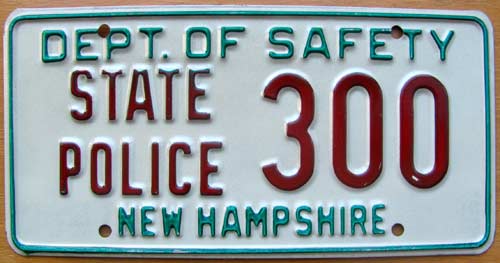 1980- 1995 issue.
1980- 1995 issue.
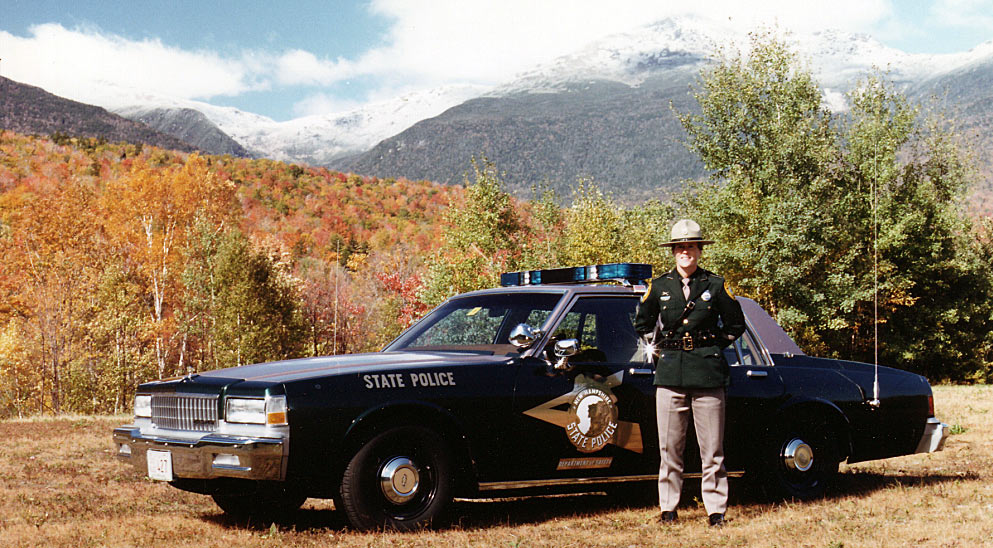 Trooper Kathy Hart. Photo taken by Trooper Skip Foisy
Trooper Kathy Hart. Photo taken by Trooper Skip Foisy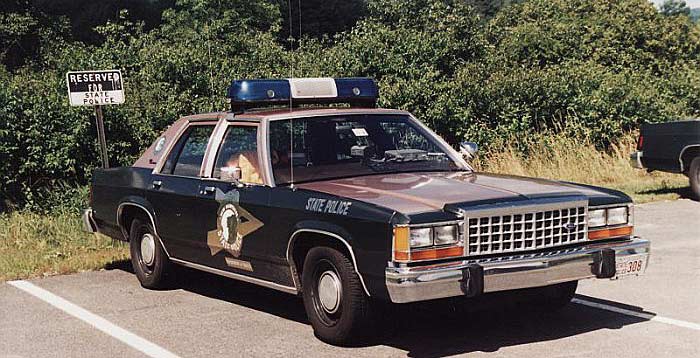
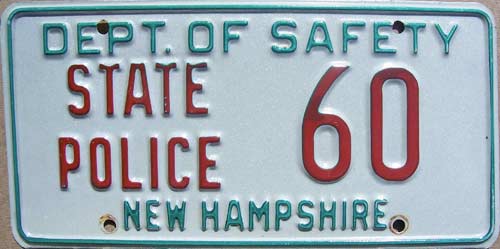 1980- 1995 issue.
1980- 1995 issue.
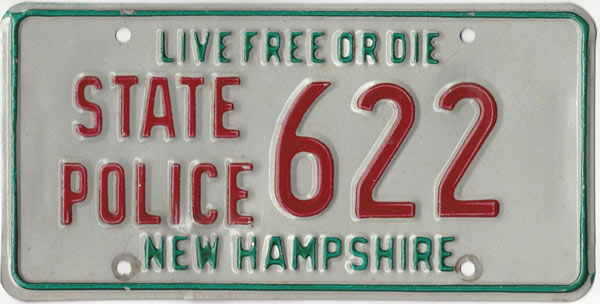 Circa 1995. Using LIVE FREE OR DIE slogan.
Circa 1995. Using LIVE FREE OR DIE slogan.
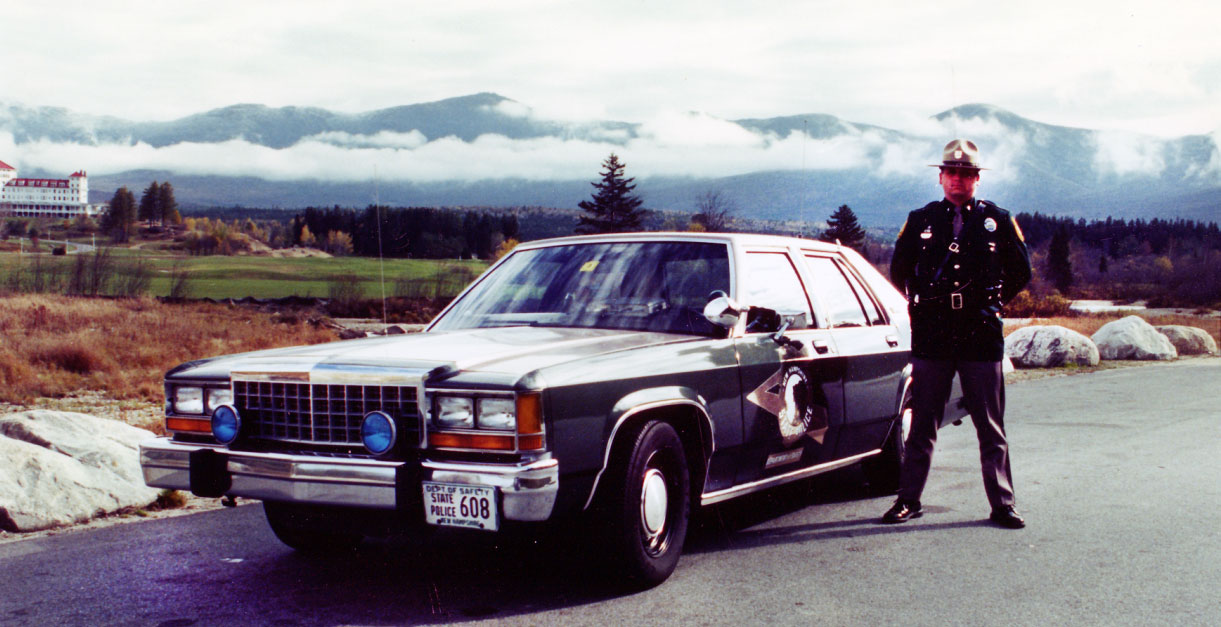 Circa 1988- Troop F
Circa 1988- Troop F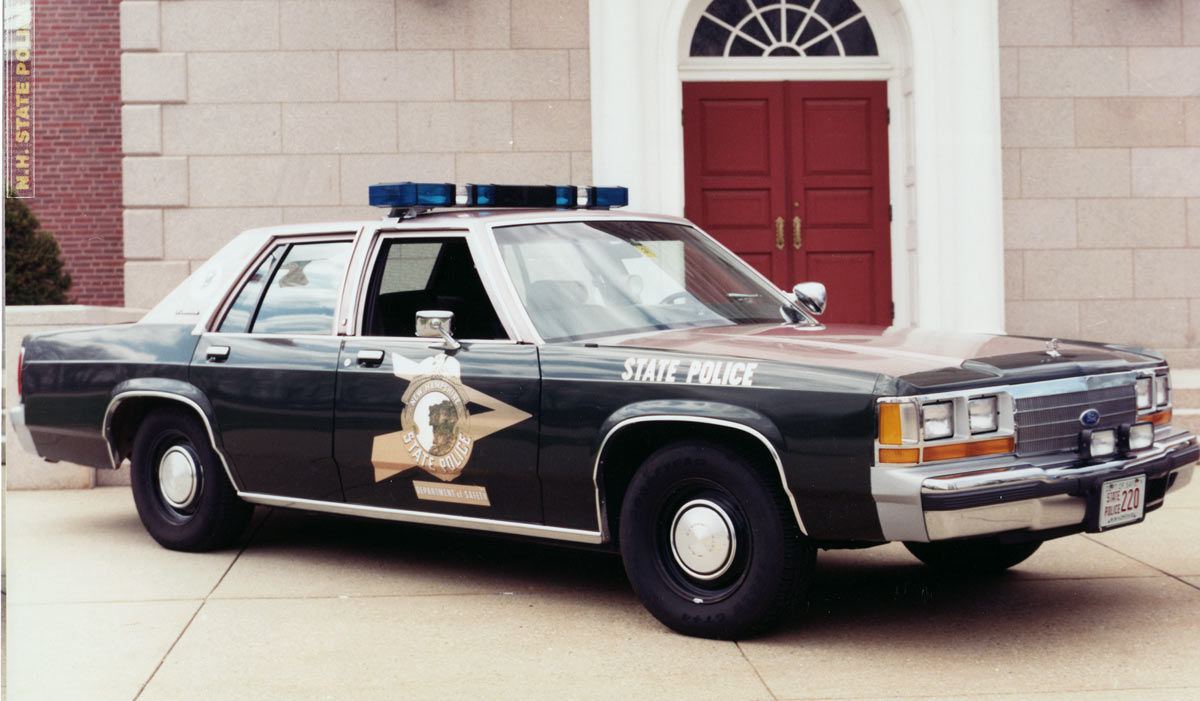 Troop B (Courtesy Kathy Kimball)
Troop B (Courtesy Kathy Kimball) 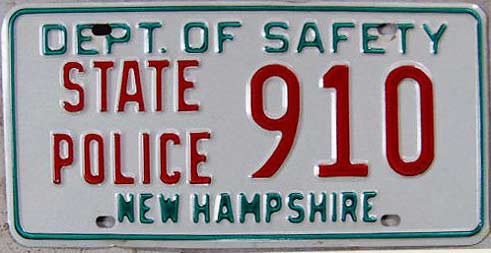 1980- 1995 issue. Later issue towards 1995 as smaller, round mounting holes replaced with elongated oval mounting holes.
1980- 1995 issue. Later issue towards 1995 as smaller, round mounting holes replaced with elongated oval mounting holes.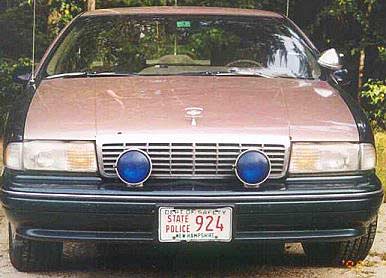 900 series- Not otherwise assigned.
900 series- Not otherwise assigned.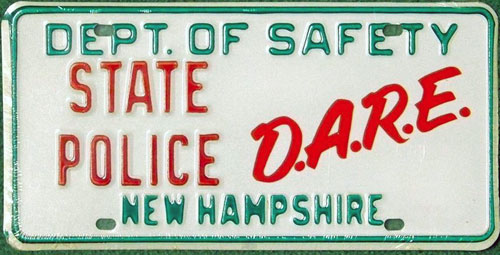 1980-1995 issue. D.A.R.E
1980-1995 issue. D.A.R.E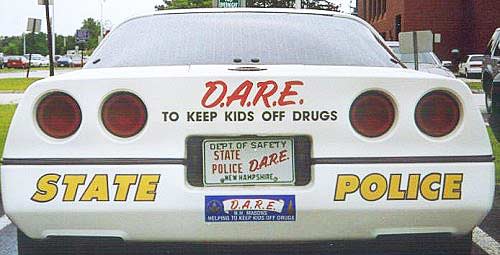 1980- 1995 issue.
1980- 1995 issue.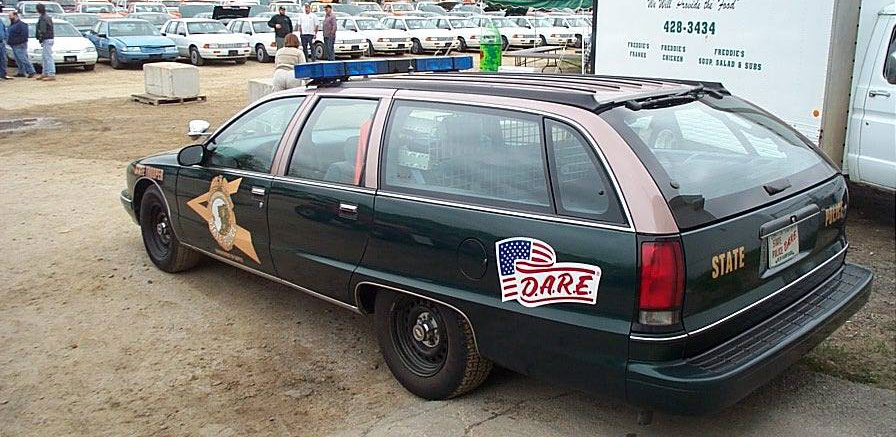
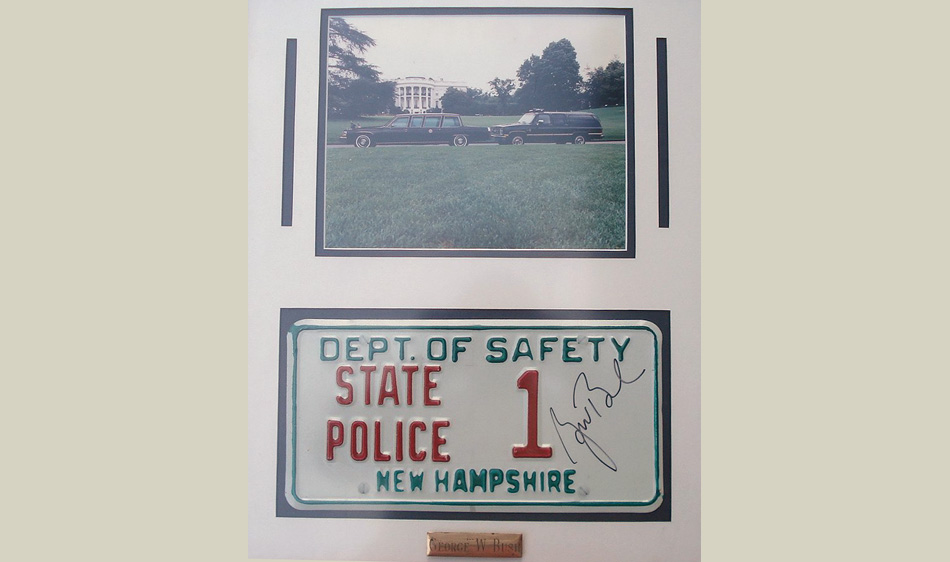
1980- 1995 issue Number 1 license plate signed by President George W. Bush.
(Courtesy of Dana Finn).
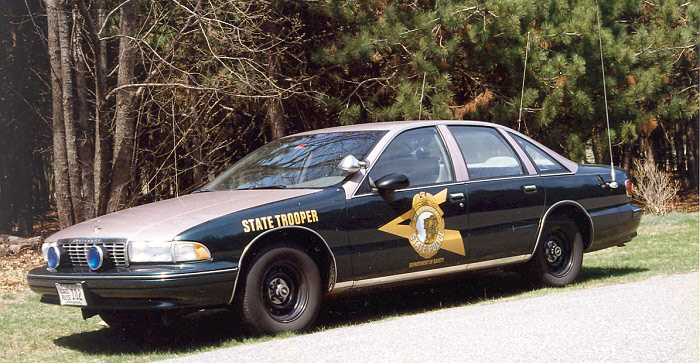
In 1996, the New Hampshire State Police issued brand new license plates as part of a fleet-wide change-over. The plates were still made of embossed aluminium with a reflective white background but used a step border instead of an embossed border. The inside line of the step border was silkscreened in medium green, as was DEPT. OF SAFETY along the top of the plate and NEW HAMPSHIRE between the lower mounting holes. The only embossed part of the plate was the monicker STATE over POLICE and the assignment number up to three digits which were all painted in red.
The practice of painting the red over the green was discontinued when this base was introduced.
These plates used subdued holograms embedded in the reflective sheeting which showed a vertical pattern of state silhouettes with 96 in the center.
These plates did not prove popular and were only used until late 1998.
t was during this time that NHSP license plates in the 700-750 series were assigned to the Bureau of Enforcement and numbers 760-765 were attributed to members of the Gaming Enforcement Unit who are civilian members of the State Police.
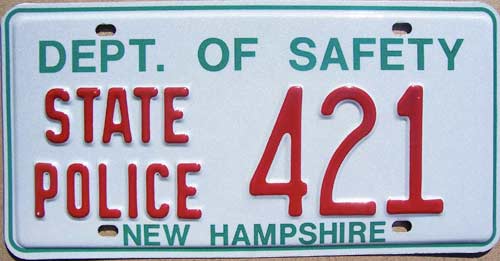 1996-1998 issue. First silkscreen and embossed combination.
1996-1998 issue. First silkscreen and embossed combination.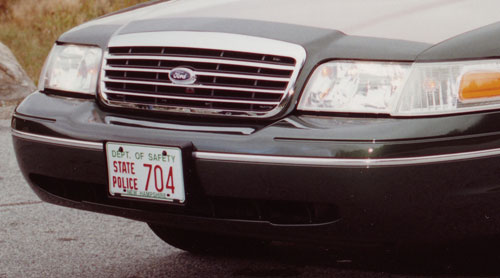 700 series during this time was assigned to the Bureau of Enforcement.
700 series during this time was assigned to the Bureau of Enforcement.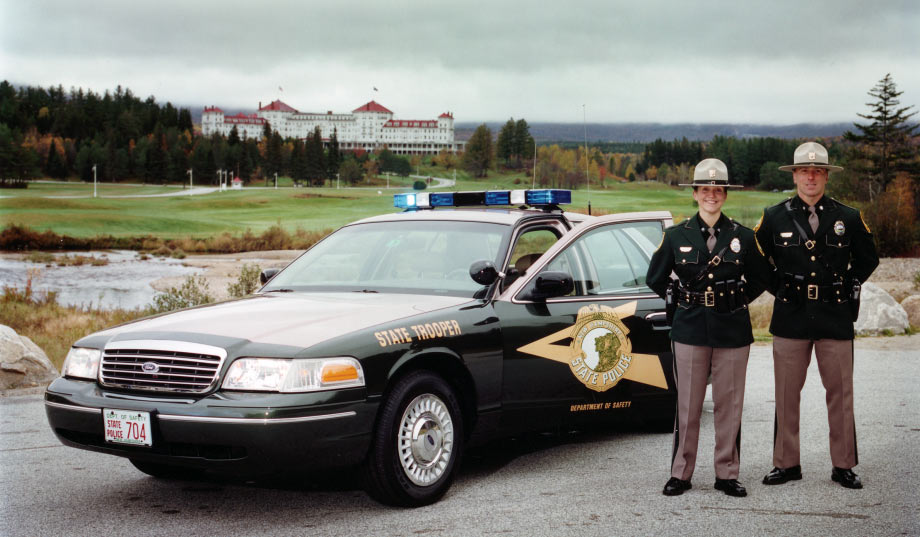 (Courtesy Mike Doucette)
(Courtesy Mike Doucette)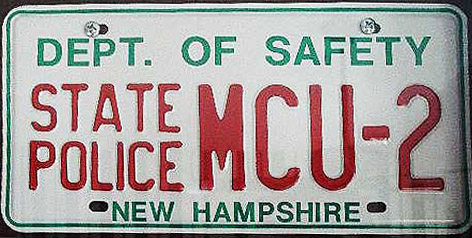 1996-1998 issue. First silkscreen and embossed combination.
1996-1998 issue. First silkscreen and embossed combination.
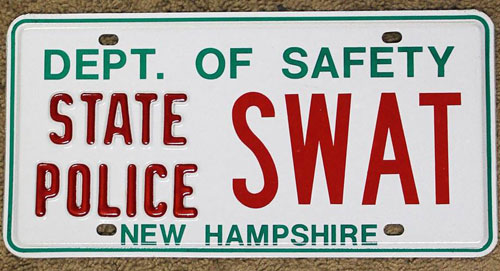 1996-1998 issue. First silkscreen and embossed combination.
1996-1998 issue. First silkscreen and embossed combination.
1998 saw the introduction of what would prove to be the longest running design and layout of New Hampshire State Police license plates. The new plates were still made of embossed aluminum and with a step border but with no contrasting outline. The state motto LIVE FREE OR DIE was centered between the upper mounting holes in medium green.
The embossed portions of the plate were as with the last version; the monicker of STATE over POLICE and the assignment number up to three digits and were still painted in red.
DEPARTMENT OF SAFETY was spelled-out in its entirety in medium green silkscreened letters and centered just above the state name which was still situated between the lower mounting holes.
Troop G was re-launched again in 2008 and merged the Bureau of Enforcement back into the NHSP.
This version is still in use as of this writing.
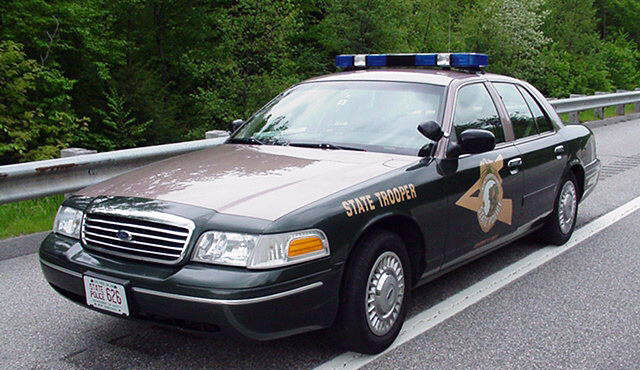
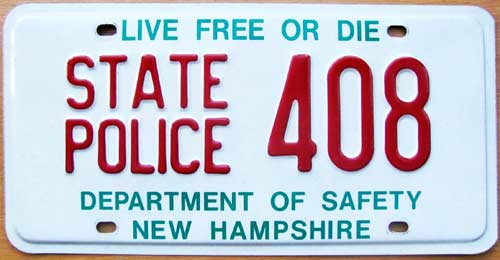 1997-current issue.
1997-current issue. 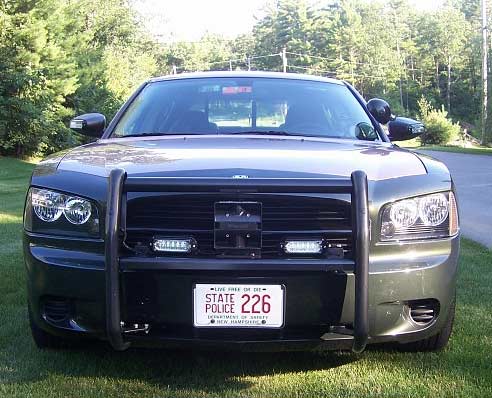

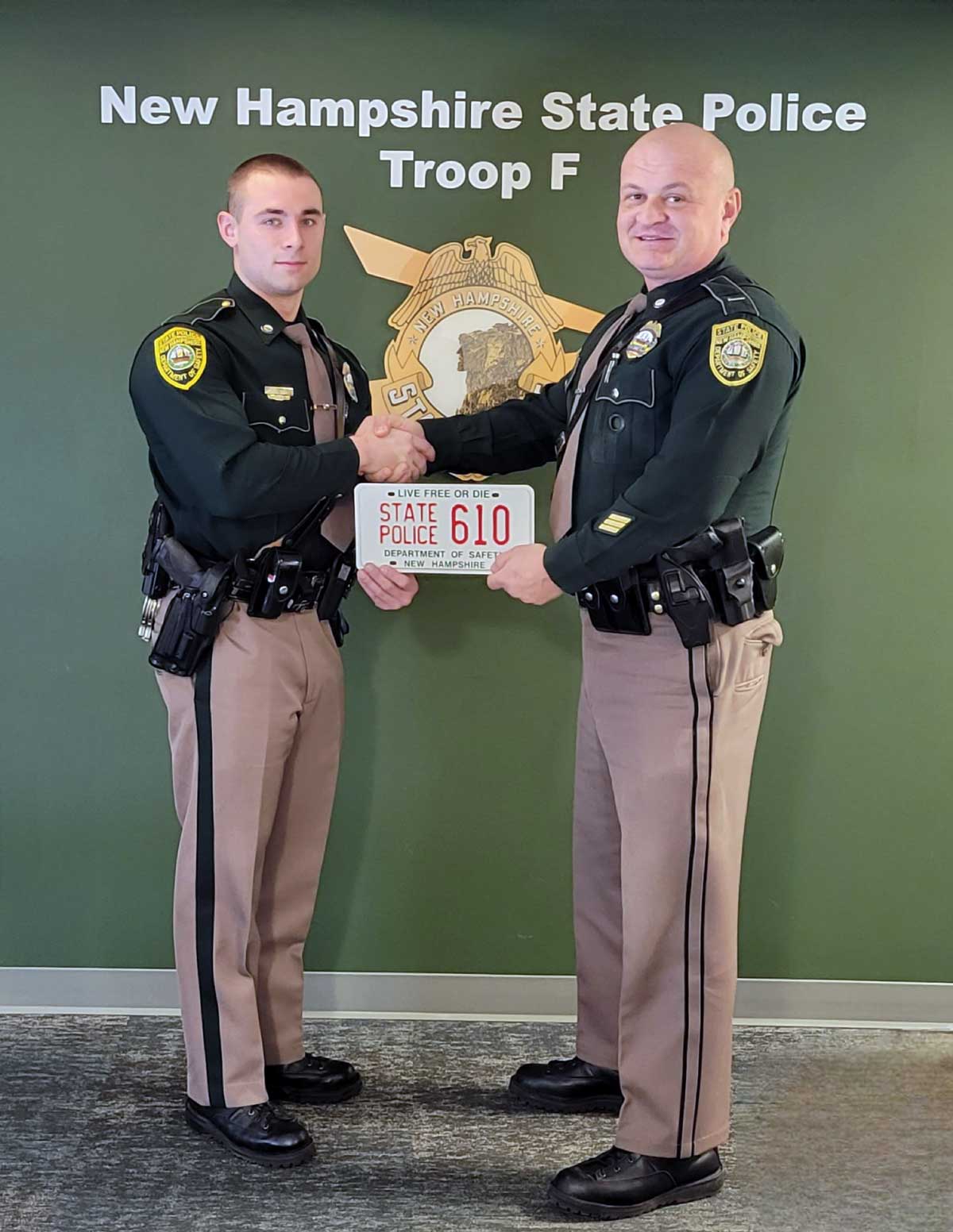 After completing the one year probationary calendar running #800 series NHSP license plates on their cruisers , NHSP Troopers are "born".
After completing the one year probationary calendar running #800 series NHSP license plates on their cruisers , NHSP Troopers are "born". 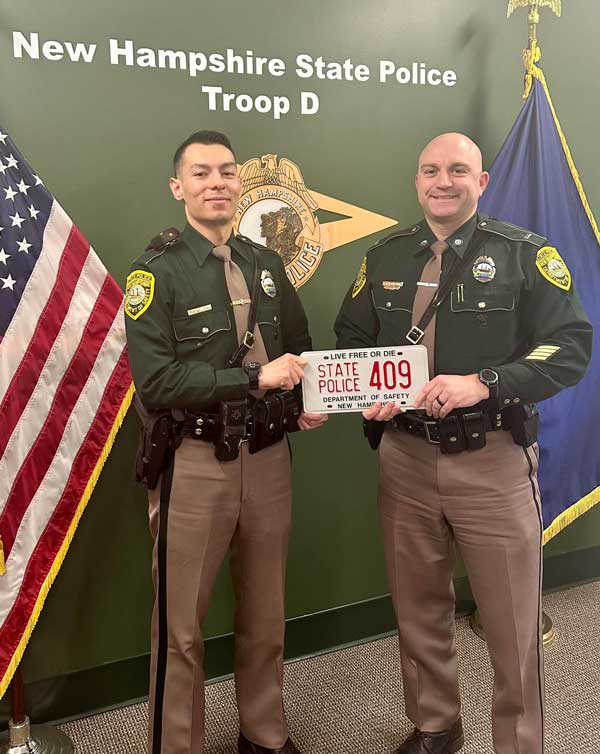 After completing the one year probationary calendar running #800 series NHSP license plates on their cruisers, NHSP Troopers are "born".
After completing the one year probationary calendar running #800 series NHSP license plates on their cruisers, NHSP Troopers are "born".  1997-Current issue.
1997-Current issue. (Courtesy John Biro)
(Courtesy John Biro)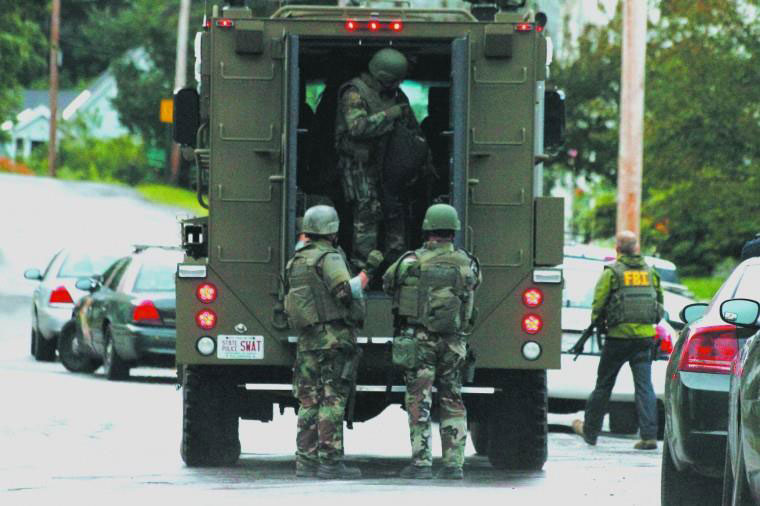 (Courtesy Chris Cooper)
(Courtesy Chris Cooper)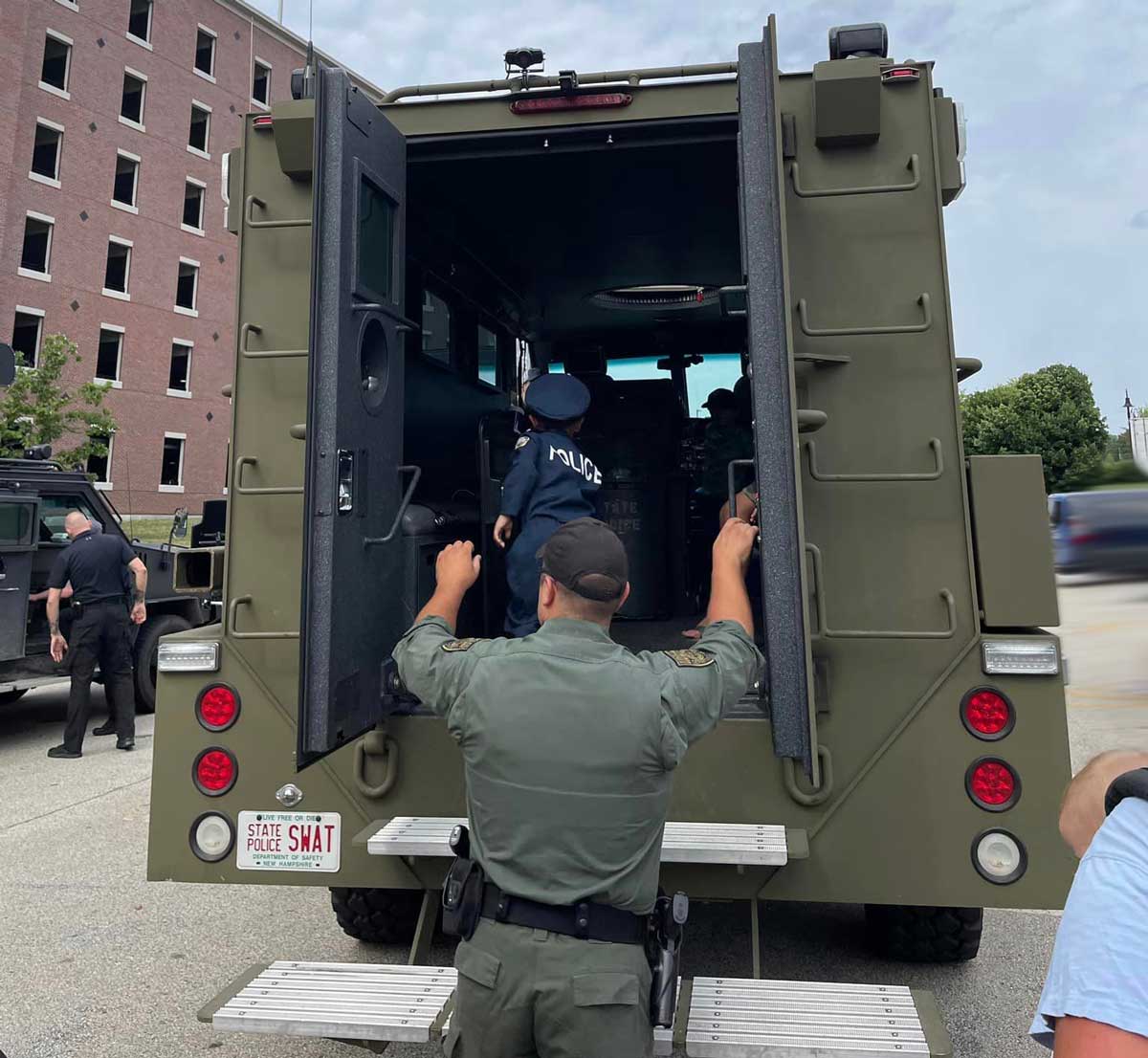 (Courtesy Jim Aitken)
(Courtesy Jim Aitken)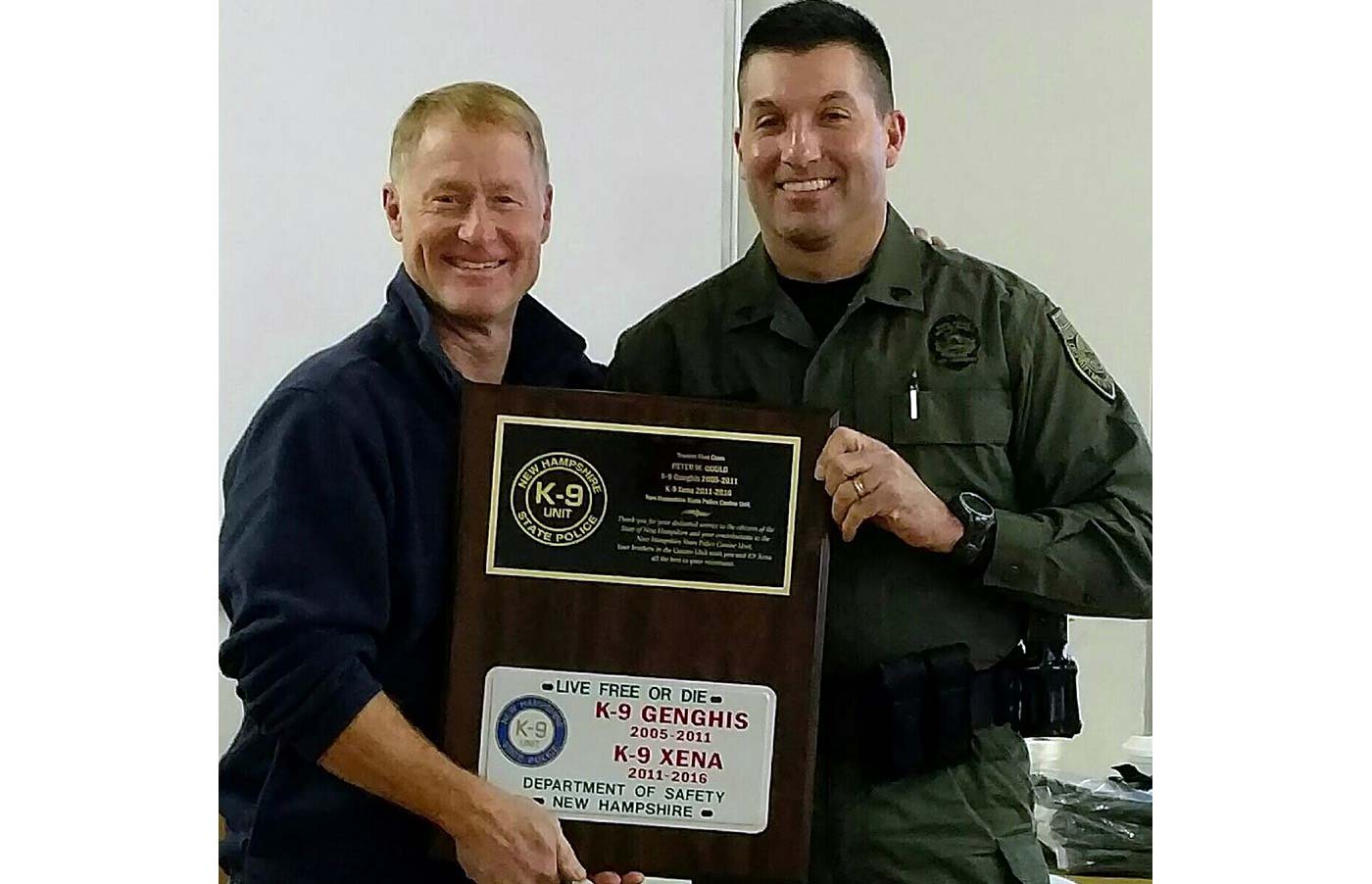 NHSP Canine Unit recognition plaque- Peter Gould for K-9 Genghis and K-9 Xena.
NHSP Canine Unit recognition plaque- Peter Gould for K-9 Genghis and K-9 Xena. The earliest motorcycle license plates used by the New Hampshire State Police were regular-issue motorcycle license plates with low numbers. Most of the numbers seen on the earliest NHSP motor units had numbers from the 10's up into the 50's.
It is unknown exactly what year it was when the NHSP began to run agency-specific motorcycle plates, but it is a safe bet judging by the materials and format seen, that it was the mid to late 1980's when the first such license plate was used by NHSP motors.
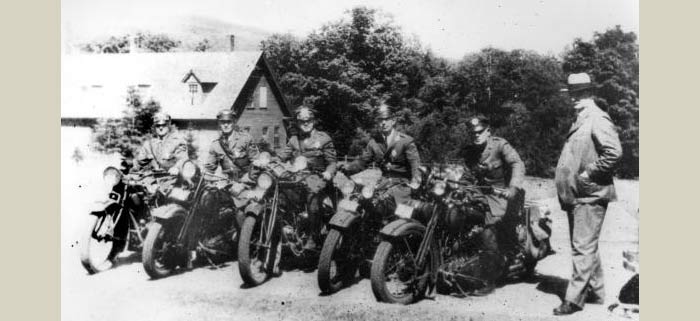 (Courtesy Michael Doucette)
(Courtesy Michael Doucette)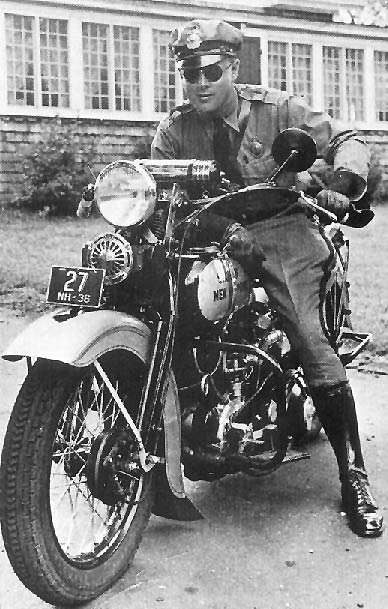
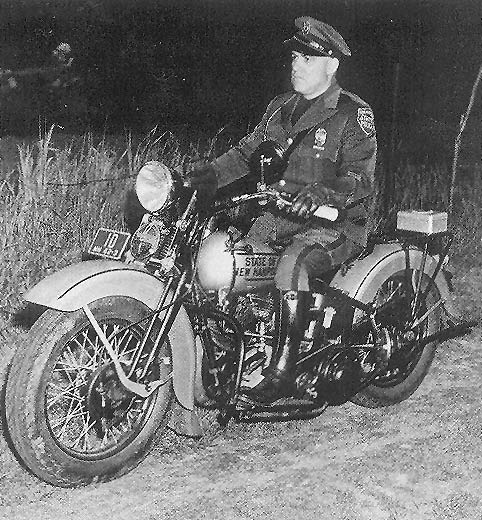
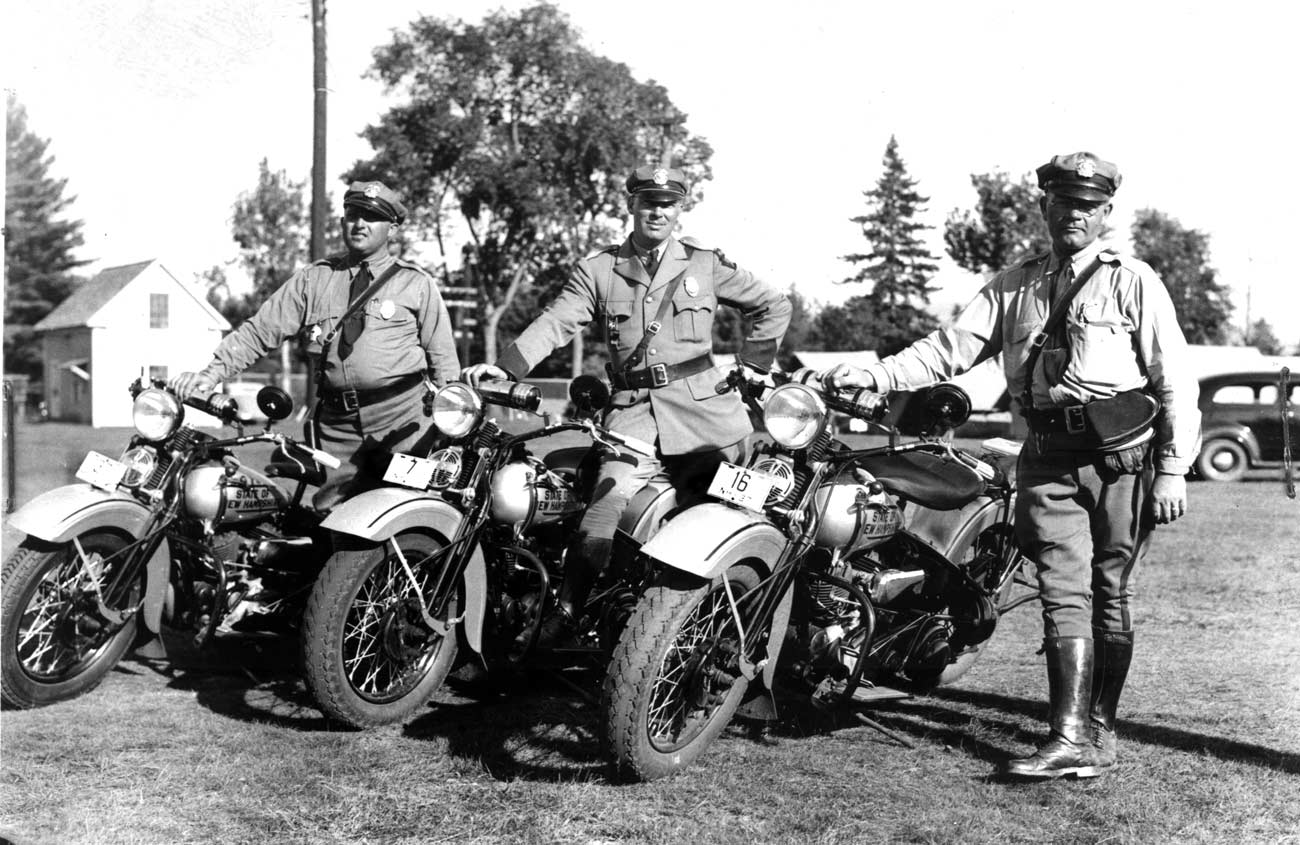
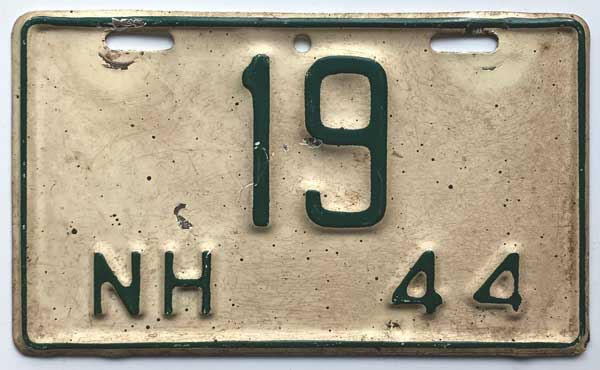 1944 issue. Embossed steel. 6" x 3 1/2"
1944 issue. Embossed steel. 6" x 3 1/2"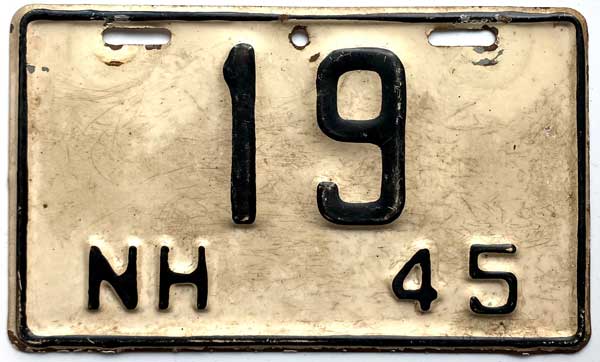 1945 issue. Embossed steel. 6" x 3 1/2"
1945 issue. Embossed steel. 6" x 3 1/2"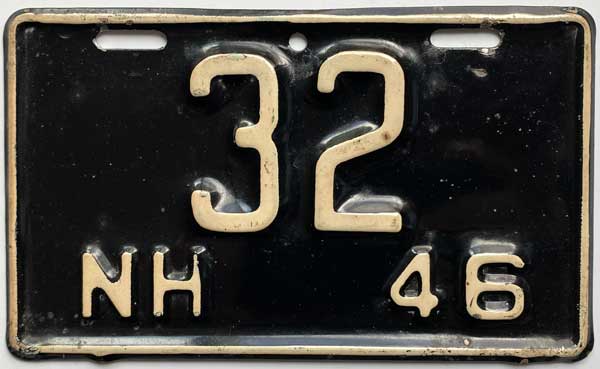 1946 issue. Embossed steel. 6" x 3 1/2"
1946 issue. Embossed steel. 6" x 3 1/2"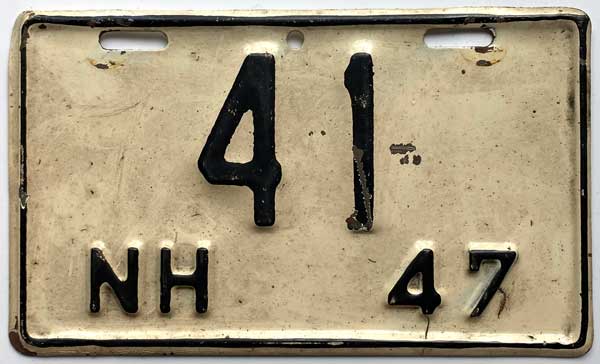 1947 issue. Embossed steel. 6" x 3 1/2"
1947 issue. Embossed steel. 6" x 3 1/2"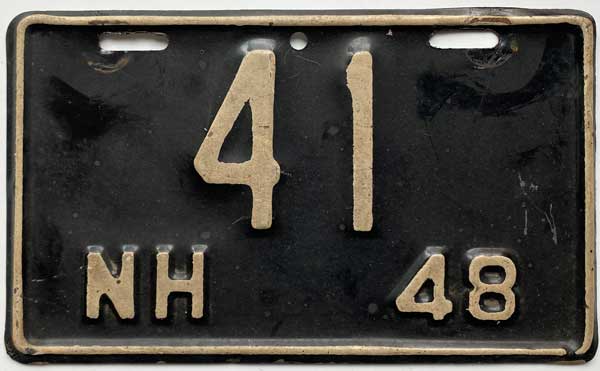 1948 issue. Embossed steel. 6" x 3 1/2"
1948 issue. Embossed steel. 6" x 3 1/2"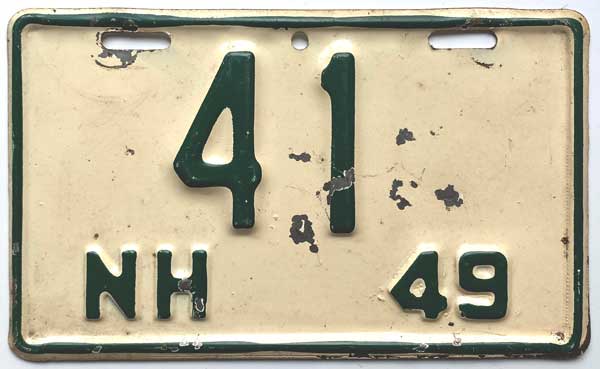 1949 issue. Embossed steel. 6" x 3 1/2"
1949 issue. Embossed steel. 6" x 3 1/2"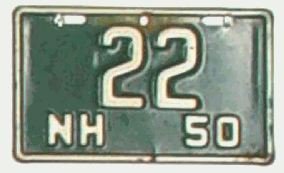 1950 issue. Embossed steel. 6" x 3 1/2"
1950 issue. Embossed steel. 6" x 3 1/2"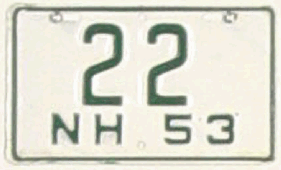 1953 issue. Embossed steel. 6" x 3 1/2"
1953 issue. Embossed steel. 6" x 3 1/2"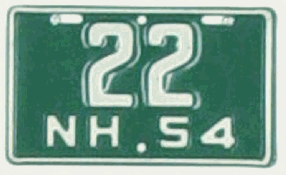 1954 issue. Embossed steel. 6" x 3 1/2"
1954 issue. Embossed steel. 6" x 3 1/2"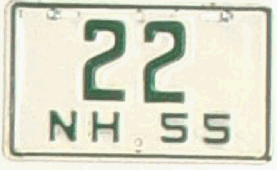 1955 issue. Embossed steel. 6" x 3 1/2"
1955 issue. Embossed steel. 6" x 3 1/2"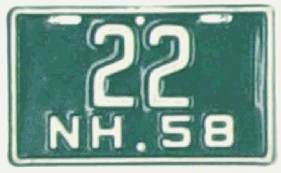 1958 issue. Embossed steel. 6" x 3 1/2"
1958 issue. Embossed steel. 6" x 3 1/2"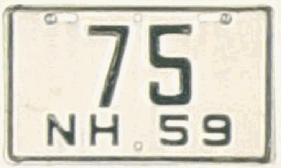 1959 issue. Embossed steel. 6" x 3 1/2"
1959 issue. Embossed steel. 6" x 3 1/2"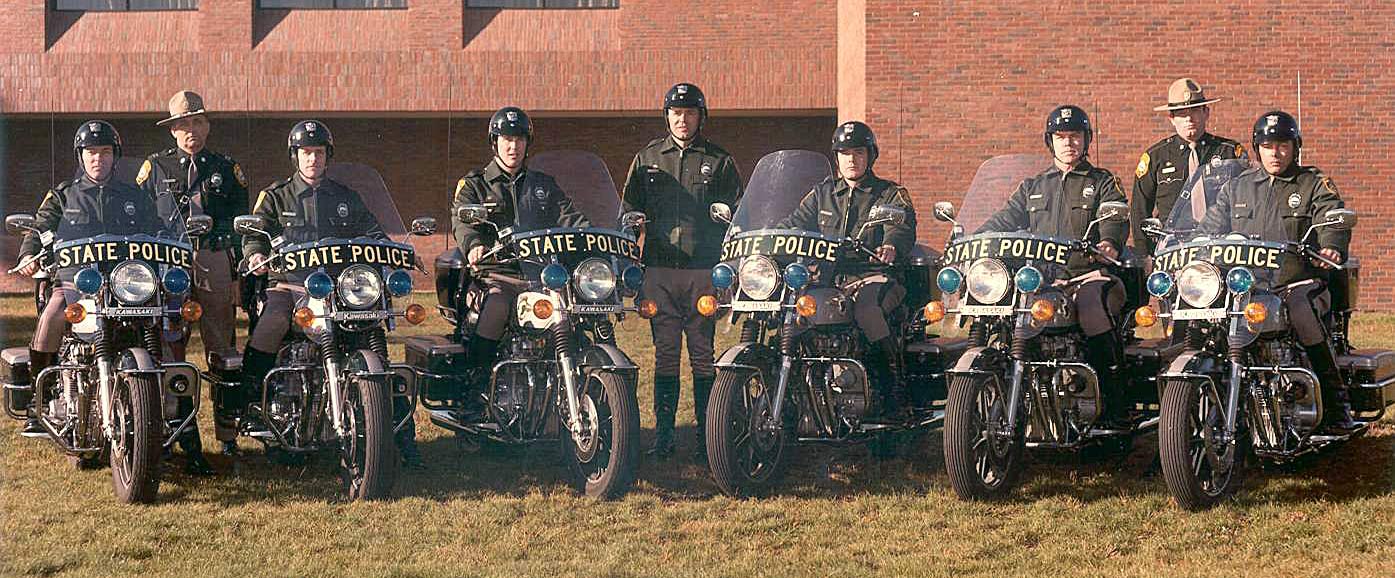
It is believed to be in the vicinity of 1978-1979 that the agency-specific motorcycle license plate was introduced to the NHSP. This is based on the fact that it was around this time that the NHSP reintroduced the use of the motorcycle to patrol use after a long hiatus. The plates were made of embossed aluminum and measured 4" x 7". The plates had a reflective white background and an embossed border painted in medium green. Much like the larger plates of the era, the embossed assignment number was originally painted green and then repainted in red.
The state name was silkscreened in medium green along the top portion of the plate and MOTORCYCLE was silkscreened in medium green along the lower center line.
The monicker STATE over POLICE was silkscreened in red next to the assignment number up to two digits.
A newer version of the NHSP motorcycle license plate was introduced likely in the early 2000's. The plate was similar to the previous issue with the exception of no green embossed border (step border instead) and the embossed numerals were painted green.
The font used for the silkscreened portions of the of the plate varied slightly from the previous issue.
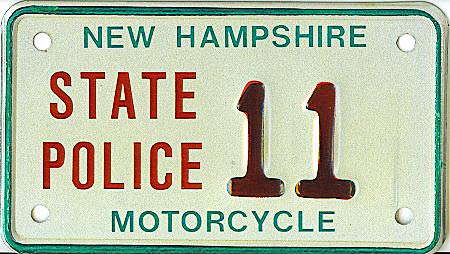 Circa 1979-2000 motorcycle issue.
Circa 1979-2000 motorcycle issue.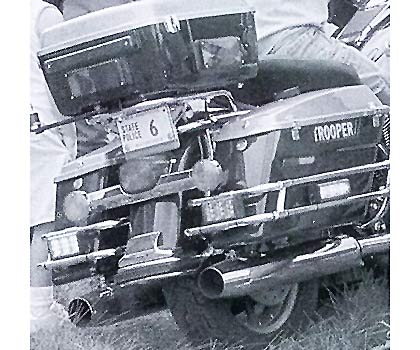
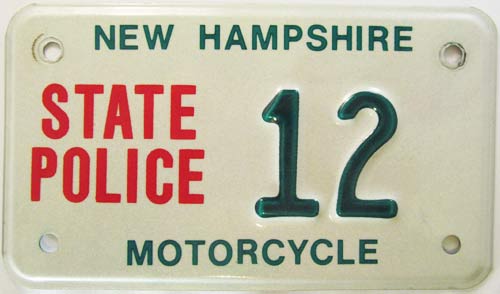 Circa 2000-current motorcycle issue.
Circa 2000-current motorcycle issue.
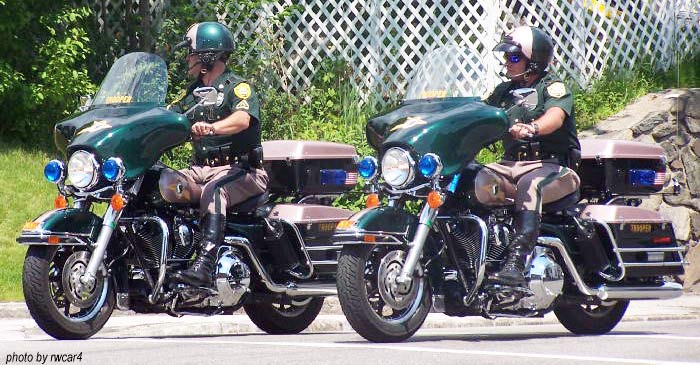
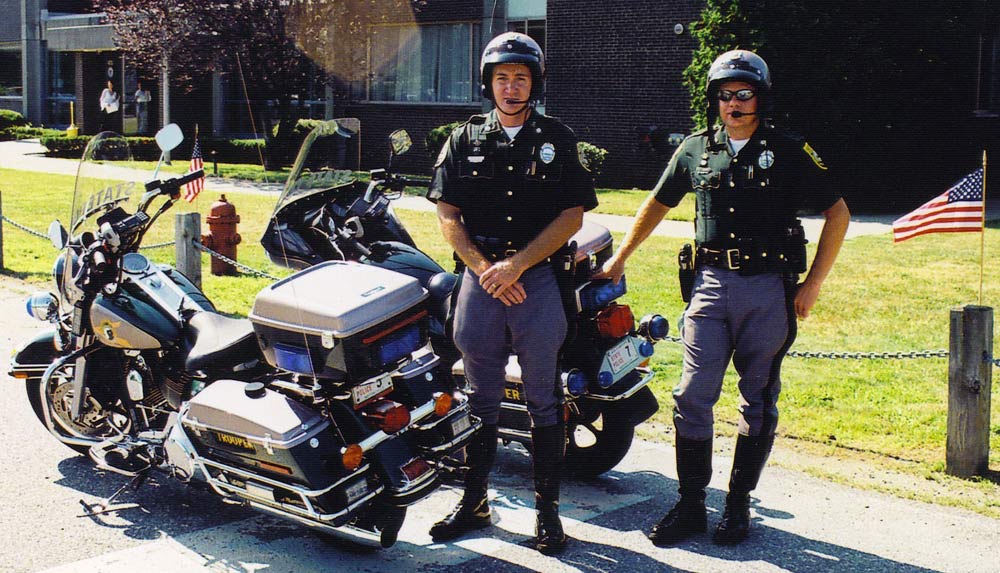
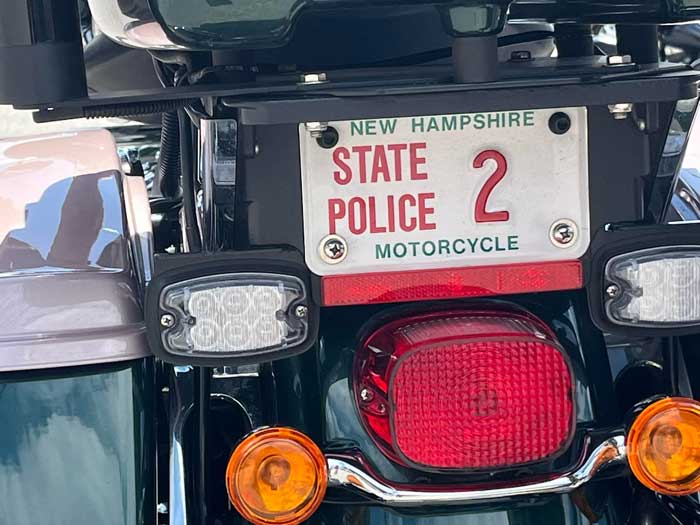 2022 NHSP m/c # 2
2022 NHSP m/c # 2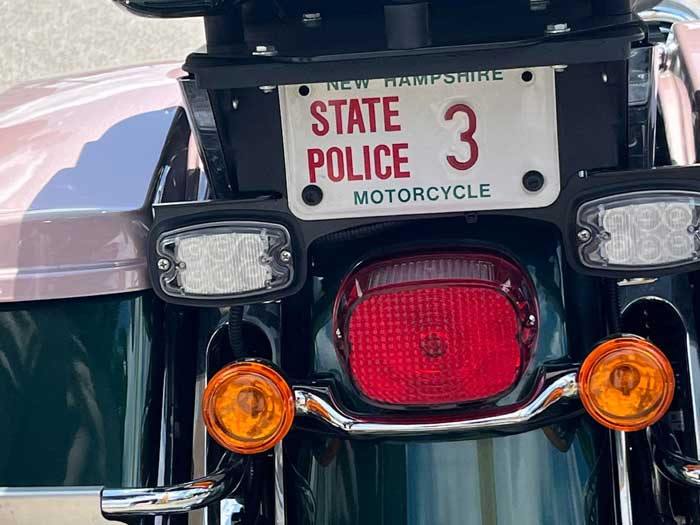 2022 NHSP m/c # 3
2022 NHSP m/c # 3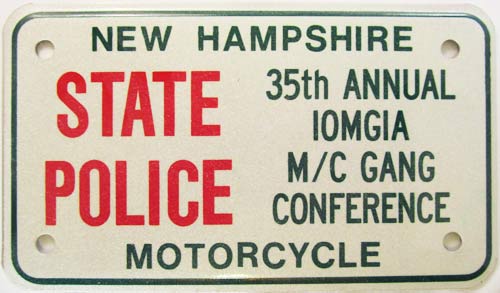 Souvenir license plate for the 35th Annual International Organized Motorcycle Gang Investigators Association Conference which was hosted that year by the NHSP.
Souvenir license plate for the 35th Annual International Organized Motorcycle Gang Investigators Association Conference which was hosted that year by the NHSP.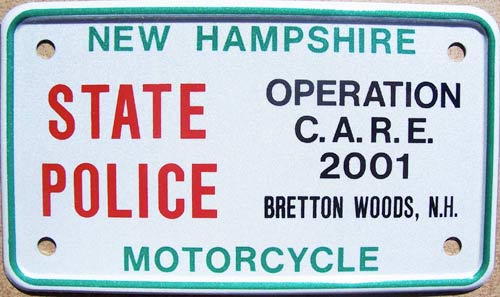 Souvenir license plate for the 2001 Operation C.A.R.E. (Combined Accident Reduction Effort) conference hosted by NHSP in Bretton Woods.
Souvenir license plate for the 2001 Operation C.A.R.E. (Combined Accident Reduction Effort) conference hosted by NHSP in Bretton Woods. 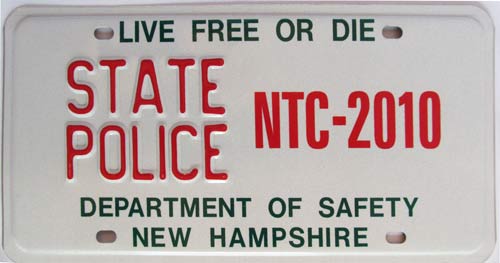 National Troopers Coalition conference delegate souvenir license plate. Hosted by NHSP 2010.
National Troopers Coalition conference delegate souvenir license plate. Hosted by NHSP 2010.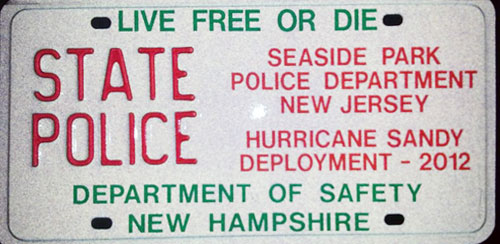 Special souvenir issue for NHSP personnel deployed to assist Seaside Park PD in New Jersey in the aftermath of Hurricane Sandy in 2012.
Special souvenir issue for NHSP personnel deployed to assist Seaside Park PD in New Jersey in the aftermath of Hurricane Sandy in 2012.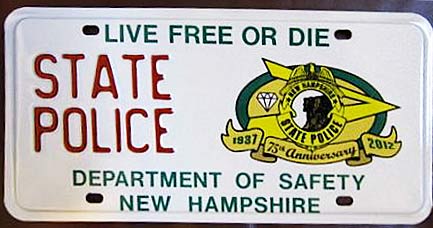 2012 NHSP 75th Anniversary souvenir license plate.
2012 NHSP 75th Anniversary souvenir license plate.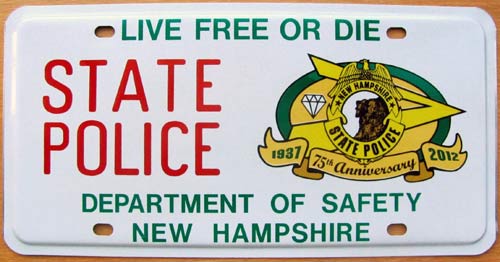 2012 NHSP 75th Anniversary souvenir license plate.
2012 NHSP 75th Anniversary souvenir license plate.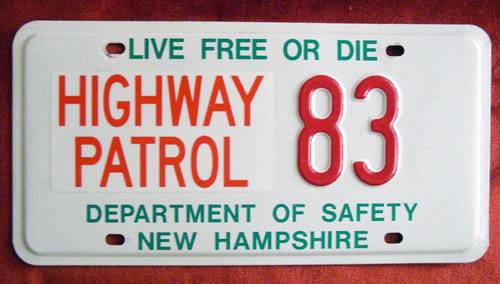 Unofficial prototype license plate created by member(s) of the New Hampshire Highway Patrol and Enforcement.
Unofficial prototype license plate created by member(s) of the New Hampshire Highway Patrol and Enforcement. 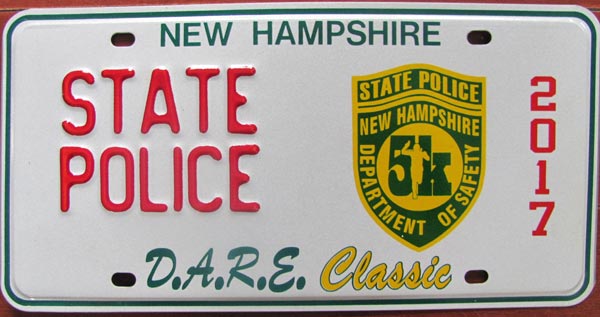 2017 DARE Classic 5K Run
2017 DARE Classic 5K Run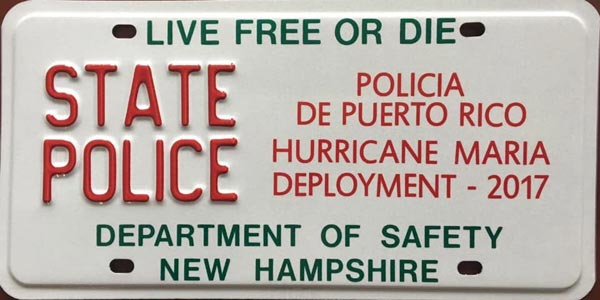 Special souvenir issue for NHSP personnel deployed to assist the police of Puerto Rico in the aftermath of Hurricane Maria in 2017.
Special souvenir issue for NHSP personnel deployed to assist the police of Puerto Rico in the aftermath of Hurricane Maria in 2017.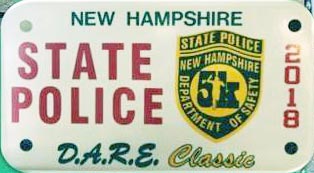 2018 DARE Classic 5K Run-Motorcycle Size
2018 DARE Classic 5K Run-Motorcycle Size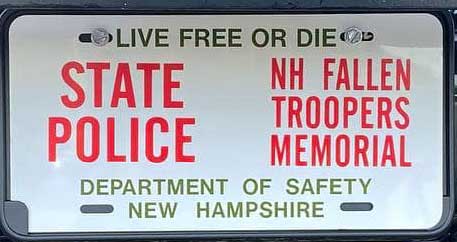 2022 NH Fallen Troopers Memorial issue.
2022 NH Fallen Troopers Memorial issue.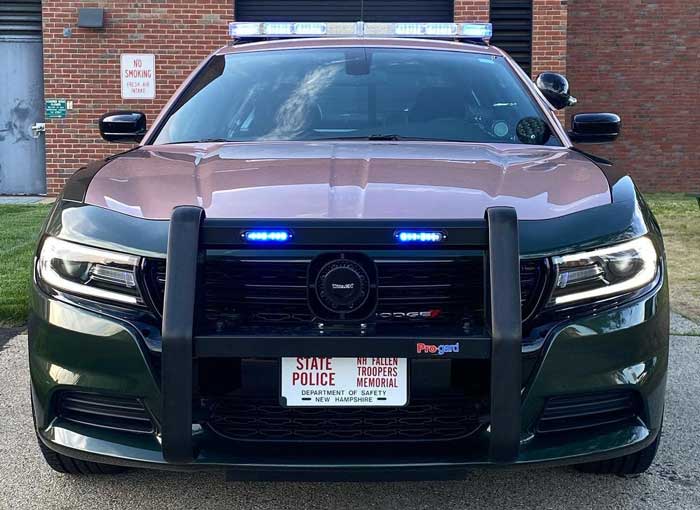
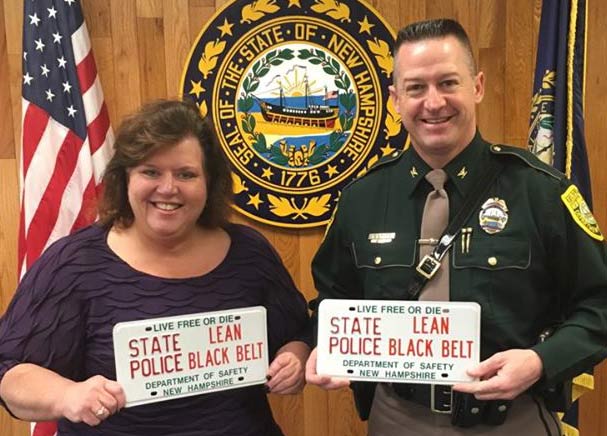 Lean Black Belt Award
Lean Black Belt Award